Genesis
 With the Leopard in 1965, Krauss-Maffei had already succeeded in providing the Bundeswehr and nearly all of Western Europe, except France and the UK, with a stunning main battle tank, the de facto "Europanzer". But even as the latter entered service, its replacement was in full development. Fifteen years after, when the Leopard 2 was unveiled, this was a sensation, which has not been challenged since. The new one was bought not only by customers of the previous Leopard, but a cohort of new customers joined in. The Leopard 2 remains, as of today, for most defense experts, the #1 MBT in Europe and, for many, the #1 worldwide, with a perfect balance between firepower, protection and mobility.
With the Leopard in 1965, Krauss-Maffei had already succeeded in providing the Bundeswehr and nearly all of Western Europe, except France and the UK, with a stunning main battle tank, the de facto "Europanzer". But even as the latter entered service, its replacement was in full development. Fifteen years after, when the Leopard 2 was unveiled, this was a sensation, which has not been challenged since. The new one was bought not only by customers of the previous Leopard, but a cohort of new customers joined in. The Leopard 2 remains, as of today, for most defense experts, the #1 MBT in Europe and, for many, the #1 worldwide, with a perfect balance between firepower, protection and mobility.
Development
Early development started right after the Leopard came into production in 1965. At that stage, new intelligence reports stated the Soviets, who had already presented the 115 mm armed T-62, were about to start building the 125 mm (4.92 in) armed T-64. In response, Rheinmetall was already working on the L44 120 mm (4.72 in) gun, which was to be used on an upgraded version of the Leopard. The MBT-70 "super-tank" joint project was initiated by the USA and Germany, and studies were already well underway. Therefore, it was given high priority. However, issues soon emerged, born from many growing divergences in specifications, measurements, and dissents over the general direction of the project. Although revolutionary, the project had large cost overruns, to the point that overpressure from the Bundestag caused the government to withdraw West Germany from the project in 1969. The USA later canceled the project itself and pursued the development of a simpler MBT, which would eventually lead to the M1 Abrams. At that stage, Krauss-Maffei started in 1970 a new project called "Keiler". This had a long development line, going through the Experimentalentwicklung and the earlier Vergoldeter Leopard, or "gilded Leopard". In 1971, the new tank was called Leopard 2, and the former was renamed "Leopard 1". No less than seventeen prototypes were ordered, but only sixteen hulls were built and trialed between 1972 and 1975. Specifications, other than carrying the new gun, was a maximum 50 metric tons in weight overall.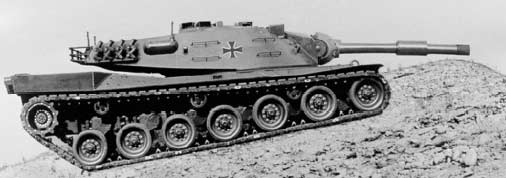
KampfPanzer 70 firing at max depression, showing the capabilities of the hydraulic suspension system.
The Experimentalentwicklung KPz (1969)
Since the late 60s this the MBT-70 (Kampfpanzer 70) complex development was running, and according to the terms of the agreement, Western Germany was not allowed to officially start its own battle tank development. Nevertheless, in order to operate the whole project, a contract was concluded for an experimental development. An agreement was signed between the MoD and Krauss-Maffei AG, finalized on 07 November 1968. In October 1969, the chassis development of the Experimentalentwicklung began. It was propelled by a 10-cylinder diesel of the MB 872 1100 type rated for 1250 PS. It was coupled with a ZF 4HP400 transmission newly and specially tailored for it.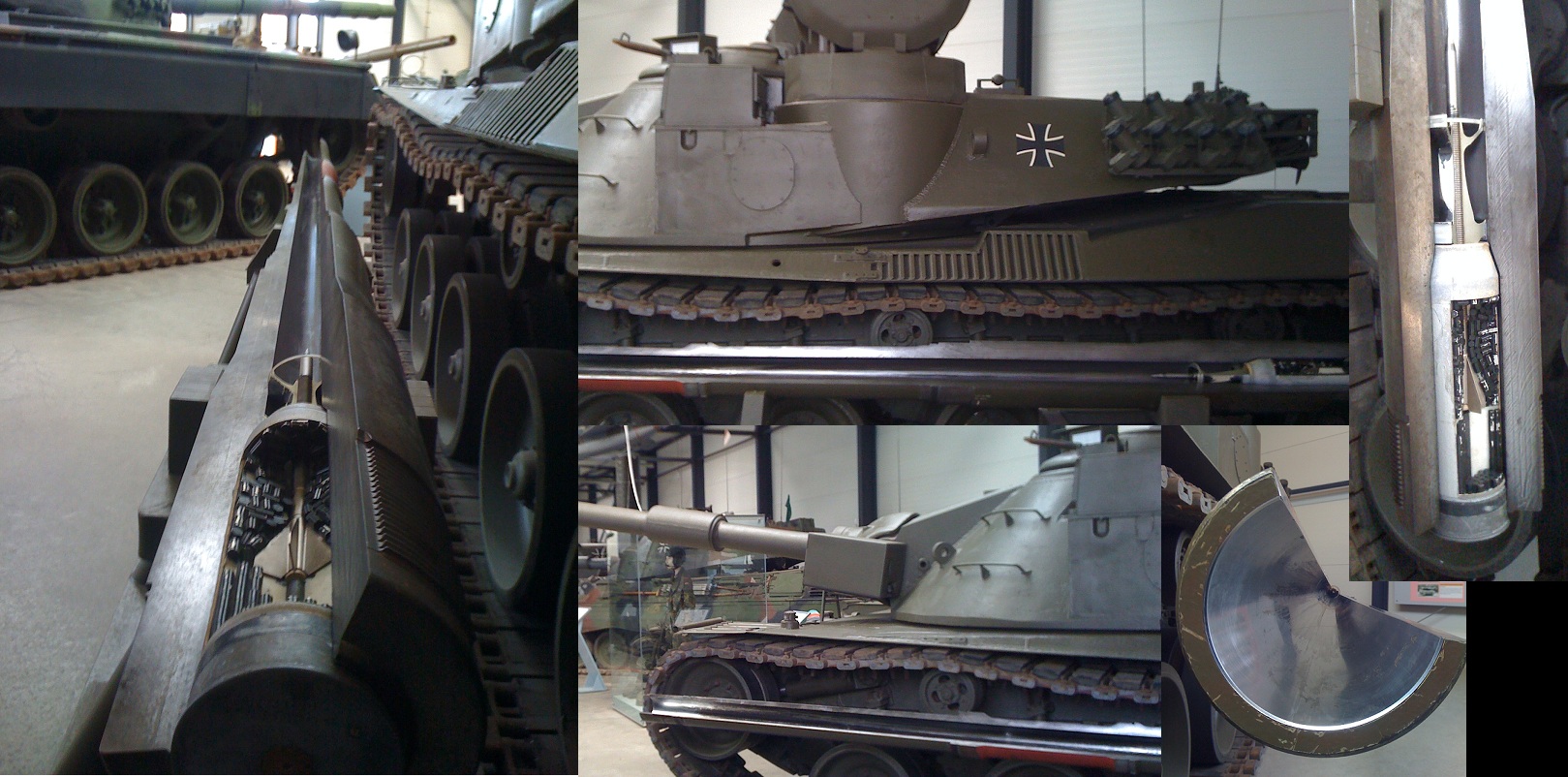
Kampfpanzer-70 at the Munster Panzer museum
The Kampfpanzer-70 and Keiler (1970)
In 1969, the whole joint MBT 70 program became apparent in jeopardy. Thereupon, the development of the now modified main battle tank with a driver installed conventionally in the hull (In the KPz 70, he was installed in the turret) under the name of "Keiler" ("wild boar") was pushed further. The official end of the MBT 70 program came in the early 70s, largely due to skyrocketing cost overruns. The then defense minister Helmut Schmidt decided further development, based on the data gained from the experimental Keiler, and renamed the program "Leopard 2 battle tank". A total order of 17 prototypes was granted (ten with 105 mm smoothbore guns and seven with 120 mm smoothbore guns). On these prototypes, engineers had to use the already fully developed engine of KPz 70, the MTU PT873 with a ring cooling system and a Renk HSWL 354 transmission. Therefore the alternative powerplant project for a The Daimler-Benz MB 872/ZF transmissions 4HP400 was discarded.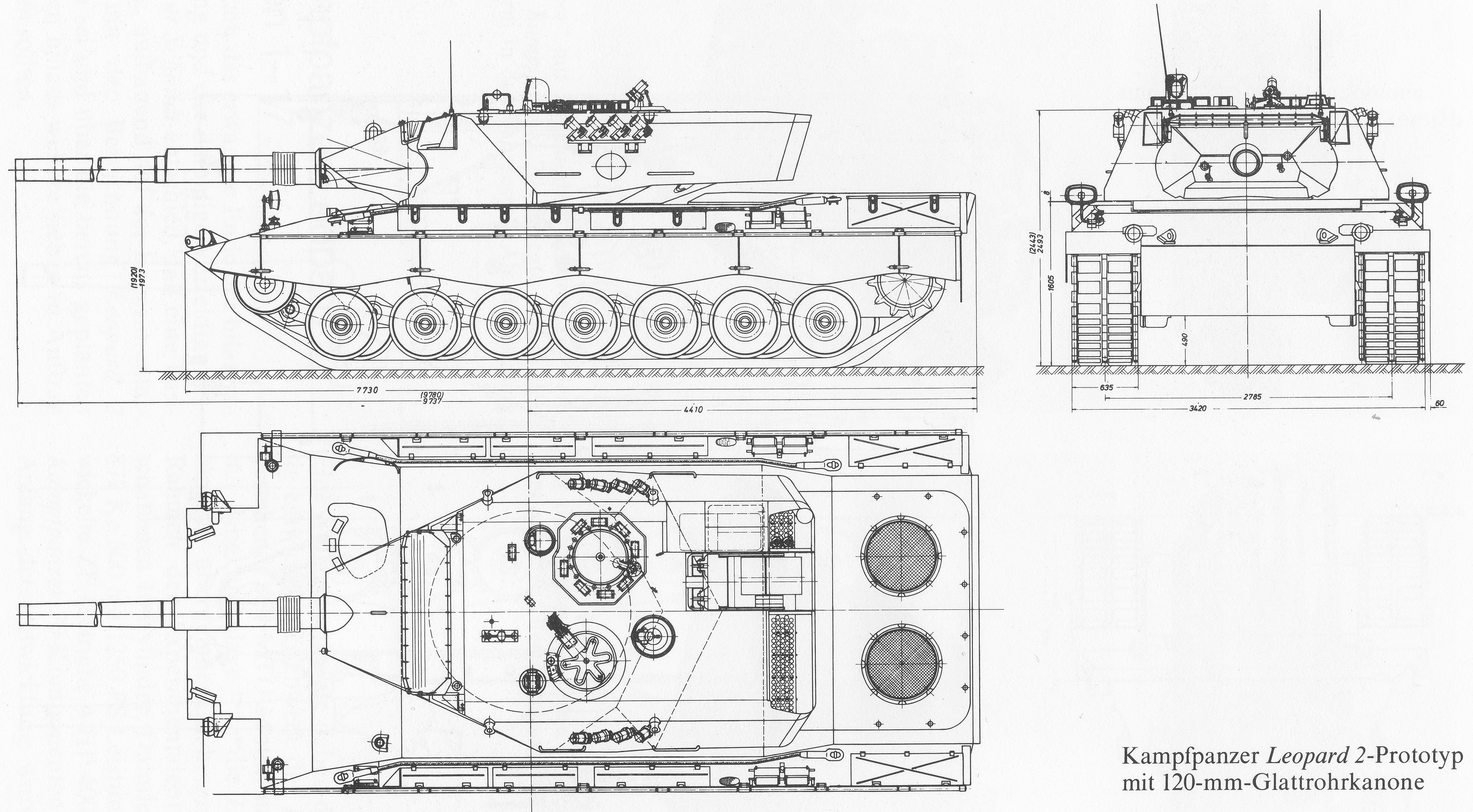
Kampfpanzer Leopard-2 Prototype or Keiler with the smoothbore 120 mm cannon
The Leopard 2K (1972)
This new pre-series project ultimately adopted was renamed "Leopard 2K", and work started to test two different suspension systems. The first was based on the experimental torsion bar suspension with friction dampers developed for the Keiler and the second was based on the MBT 70 more complex hydro-pneumatic suspension. The two prototypes were abundantly tested and compared at the Bundeswehr proving grounds 41 near Trier. After this process, it was decided to reject the second one, the hydro-pneumatic suspensions systems being believed not to be mature enough for mass production at that stage.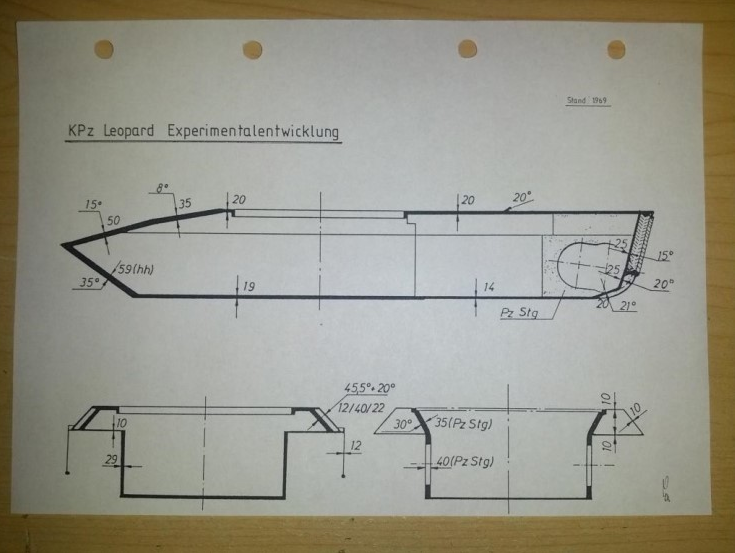
Kpz ExperimentalEntwicklung
The Erprobungsserie (1972)
The extensive testing of the sixteen prototypes took place between 1972 and 1973. The first chassis or PT3 models (turret-less) was transferred to the end of May 1972 on the 41 proving grounds near Trier for mobility testings. The first completed pre-series test vehicle with a turret started operation in June in 1972 on the 91 test site in Meppen. At the same time trials with infantry started in Germany, but also in Canada (Winter 1973/74), as well as in Arizona/USA to test extreme mid-summer temperatures. This helped to identify the main problem in compliance with the specification, which was to be below the maximum of 50 tons. Efforts have been made, the turret, for example, was redesigned to save 1.5 tons. Leitz completely redesigned the external envelope, which enabled a more favorable turret shape but also future armor upgrades as well.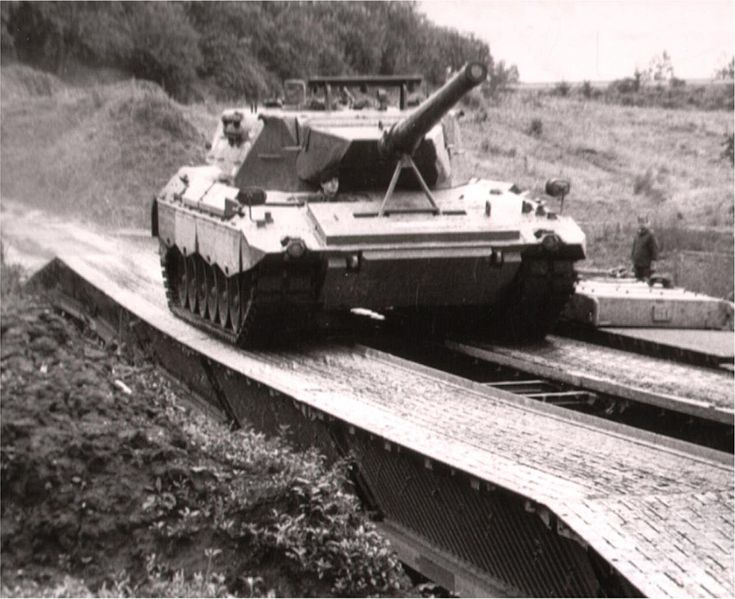
Erprobungsserie, 1973 (preserie).
Protection upgrades and MLC 60 protection specification (1973)
It was discovered after the 1973 Yom Kippur War that the armor protection was to be given a significantly higher priority. Thus, it was decided the weight saved for the turret could be used for extra armor. Meanwhile, the USA showed interest in the Leopard 2 project and purchased one of the prototypes, which significantly influenced the development of American prototype XM1 (M1 Abrams), but at the same time criticized the inadequate armor protection of the Leopard 2. Krauss-Maffei introduced at that time a concept with improved armor but it became clear for the teams involved that the 50-tons requirement could no longer be sustained, therefore an agreement was reached on the MLC 60 specification in 1973 as the upper weight limit for development.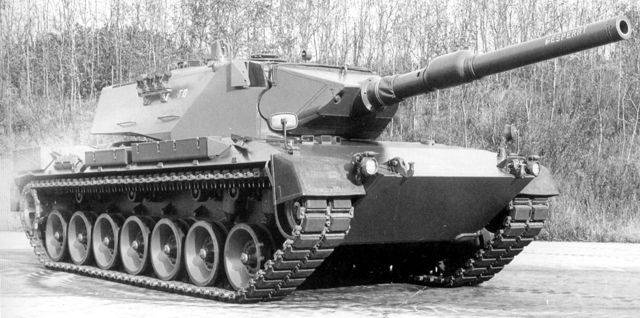
The Keiler ("Wild Boar") prototype in the late 1960s.
The Alternative upgraded Leopard 1 project
In parallel, different proposals came from companies as an alternative to the weight problem of the Leopard 2, designed to comply with the very strict MLC 50 specifications. One way was to improve the combat efficiency of the Leopard 1 in three stages, producing in three variants: Option 1: 105 mm smoothbore gun with ammunition and uprated improved armor protection Option 2: New engine rated at 1200 or 1500 hp in addition to 1 Option 3: Option 2 but with a 120 mm smoothbore gun. Depending on the British government approval, a new type of casemate armored battle tank was designed and named 3/80 MBT. None was chosen in the end since the weight problem with the Leopard 2 was solved in the meantime.The American Leopard (2AV)
Due to the interest shown by the USA to purchase or start a local production of the Leopard 2, Krauss-Maffei embarked in a series of modifications aimed at meeting the American specs. For this, the A2V was considered an "Austere Version". It featured an improved armor in compliance with the MLC 60 spec, but a simplified fire control system, a reviewed ammunition stowage protections and management, a mine-protected belly, the elimination of the auxiliary generator, and replacement by eight vehicle batteries, and the accommodation of the entire electronics and hydraulics in the turret rear (for a better access for maintenance and repair).But the story of the American Leopard was not over yet. Once the two A2V prototypes were shipped and bring to the Aberdeen Proving Grounds, they underwent extensive trials between September 1976 and March 1977, and for comparative testings against the two American prototype XM1 from Chrysler and General Motors. Since both were equipped with the 105 mm, both A2V were rearmed with the Leopard 1's 105 mm gun L7 A3. The comparison in 1977 showed that only a 120 mm cannon could match future threats leveraged by experts and shown all its superiority over the 105 mm. So despite the XM1 won at the end, the irony was that the Abrams was indeed modified in the mid-1980s to accommodate the very same 120 mm Rheinmetall smoothbore cannon, retrofitted in the US from the actual Leopard 2.
Design of the Leopard 2
Externally, the Leopard 2 was not a revolution compared to the Leopard 1, the chassis was improved but remained largely identical, although emphasis was put from the beginning in protection. Therefore the most obvious difference came from the turret, which was not only tailored for the new Rheinmetall 120 mm smoothbore cannon but also for extra composite armor compartment. Estimated protection figures (up to the 2A5) are 590–690 RHAe on the turret and 600 RHAe on the glacis and lower front hull.Chassis and hull
According to data from the Entwicklung series, the front glacis was 50 mm at 15° then 35 mm at 8°, equivalent to 90 mm of welded steel RHA with a hardened upper layer. The lower face of the beak was 59 mm at 35°. The bottom front plate (from the beak to the rear of the turret) is 19 mm and 14 mm under the engine compartment while the rear plate was 25 mm thick at 15-20°. The engine deck is 20 mm thick. All in all, this was no way superior to that of the Leopard 1 chassis, however, the compartments above the main drivetrain received new cofferdams of composite armour storage bays and are flat rather than sloped on the previous Leopard on which all the tooling was fastened externally. The driver is located to the right hand side. He is given a sliding hatch (to the right) and three periscope vision blocks before him.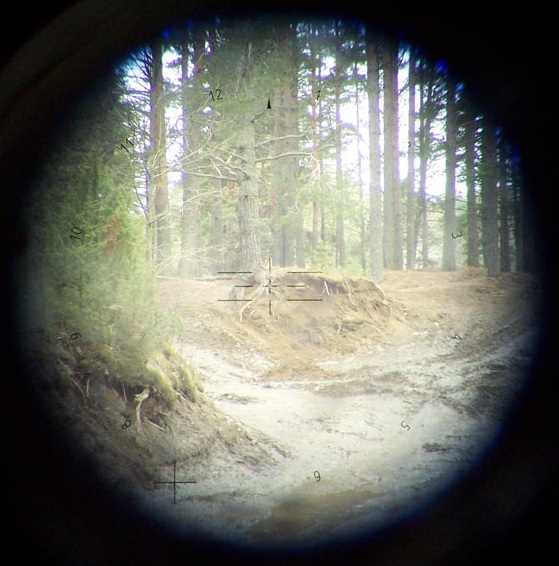
The central one could be swapped for an IR thermal vision device. Compartmentalization is straightforward, with the driving compartment, followed by the fighting compartment, and the engine compartment at the rear, separated from the crew by a fireproof bulkhead. The driver's station is protected from fire by four 9 kg Halon fire extinguisher bottles (on his right), which are activated when the temperature rose above 180° Fahrenheit with a manual backup. Another 2.5 kg Halon fire extinguisher is located beneath the gun, inside the floor of the crew compartment for better safety. There is a collective NBC system, which provides up to 4 mbar (0.004 kp/cm²) of over-pressure. In addition recently, Leopard 2A4M and 2A6Ms received an additional mine protection plate for the belly, especially efficient against mines and IEDs.
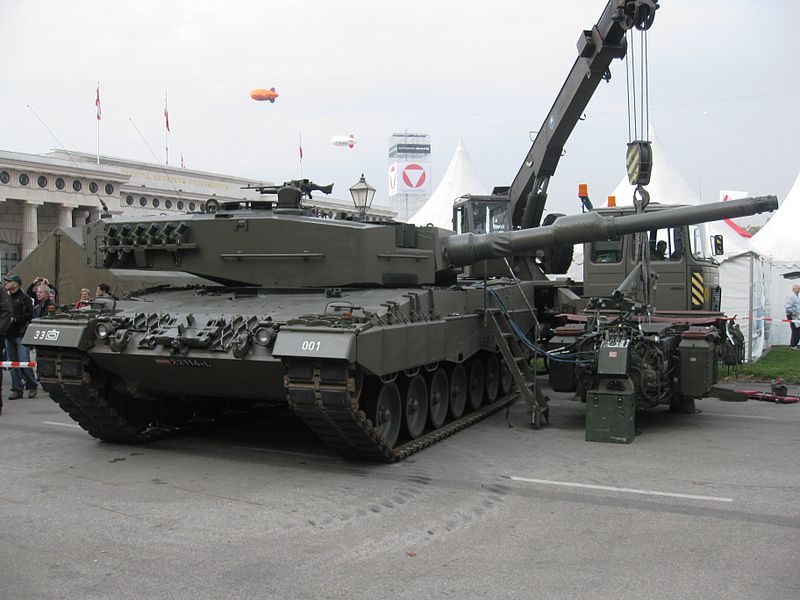
Austrian Leopard 2A4 with its MTU powerpack on display
Mobility: The MTU Engine
The Leopard 2 beating heart is the MTU MB 873 Ka-501 diesel engine. This powerful unit provides 1,500 PS (1,103 kW) at 2600 rpm of output, and the block is four-stroke, 47.6 litre, 12-cylinder multi-fuel. Its exhaust is turbo-charged, and it is liquid-cooled. Estimated fuel consumption is around 300 liters for an average of 100 km on flat but 500 liters for the same distance cross country. The transmission is the Renk HSWL 354 hydro-kinetic planetary gearbox which have four forward, two reverse gears. This automatic transmission has a torque converter. Therefore the Leopard could turn on the spot, whatever the speed is. This transmission automatically changes gear within the range pre-selected by the driver. The cooling air outlet grille is prominent over the rear plate and was reinforced and better protected after the 28th vehicle in production. In addition, an automatic fault detection system probe for any technical malfunctions and is monitored by the driver in real time.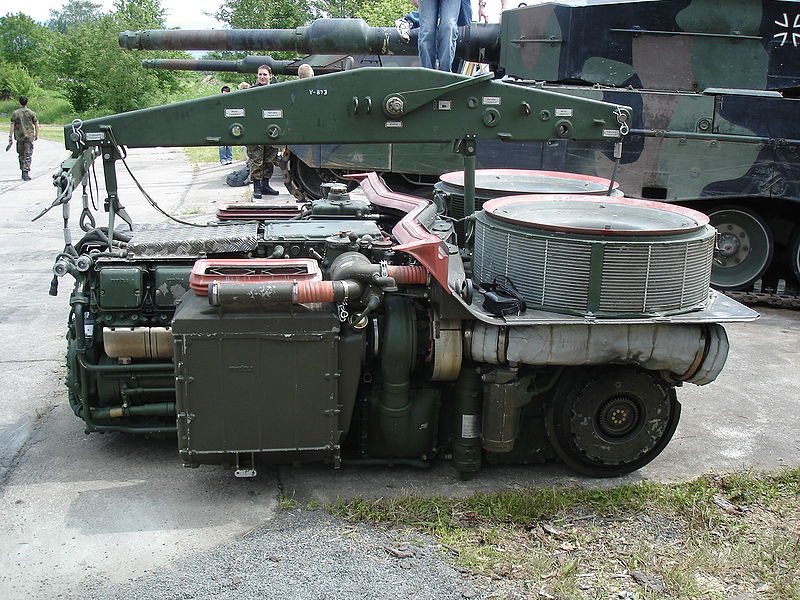
Leopard 2 MTU diesel powerpack.
The engine is fed by four fuel tanks (1,160 liters in total) for a maximum road range of about 500 km. The MB 873 is a 6.12 tons engine and can be changed in the field in just 15 to 35 minutes depending on the conditions and crews skills. Power is provided by eight 12-volt/125 Ab batteries plus a 24-volt electrical system.
Performances: Top road speed 68 km/h (limited by law to 50 km/h during peacetime), top reverse 31 km/h ( mph). The Leopard can negotiate 30° slopes, climb one meter high vertical obstacles, a three meter wide trench, or ford water 1.20 m deep without preparation, and up to a depth of 2.25 m (deep wading) with a short preparation or 15 minutes with special equipment for proper underwater driving, at 5-6 m of depth. In this case, a 3-piece snorkel is fitted above the commander's cupola for guidance. The EuroPowerPack which developed 1,650 PS (1,214 kW) MTU MT883 undergone trials in the 1990s but was not adopted so far for production although it remains an option.
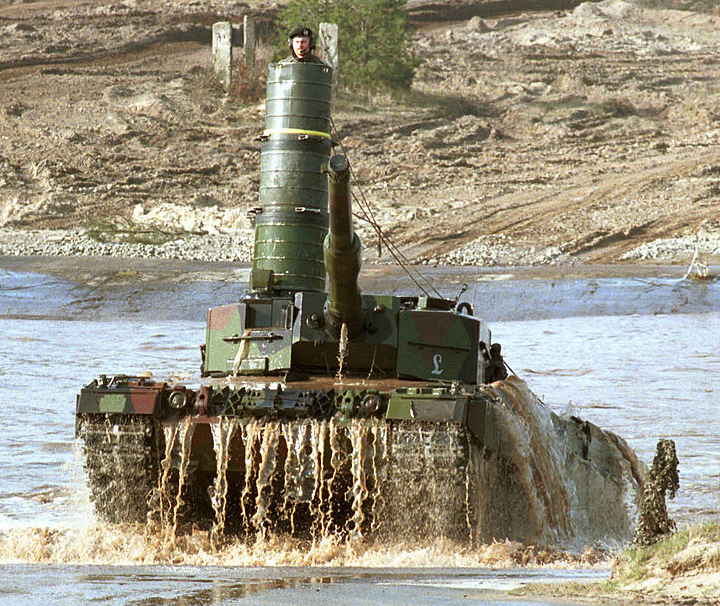
Leopard 2A4 in deep wading gear, showing its snorkel
Drivetrain
The Leopard 2 used a torsion bar suspension with advanced friction dampers. They served seven dual rubber-tired road wheels (same type and diameter as the Leopard 1) and four return rollers per side. The the idler wheel is at the front and drive sprocket at the rear. 570F tracks are made by Diehl, rubber-bashed with end connectors, and possessed removable rubber pads. Each track is composed of 82 links. Up to 18 rubber pads could also be replaced by grousers for extra grip on the mud and snow, usually stored on the vehicle's bow. Three large side skirt panels are protecting the wheeltrain upper part, whereas the first two road wheels and idler are covered by three smaller side skirt panels.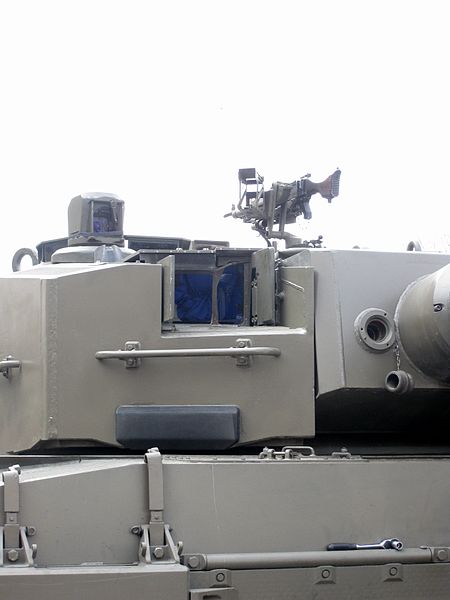
Turret design
The particular turret design of the leopard 2 which is its most obvious feature looks slab-sided, but is probably four or five times better protected by the original turret due to the adoption early on of massive multi-layered composite armor blocks. Seen from above this turret is simple in design, with flat sides and a sloped front. The mantlet is relatively large and boxy. Handling bars are welded on the front and sides, to help the crew to climb onto the roof, which receive anti-skid coatings. Three towing eyes are also welded, on in the front, centerline, and two other on the rear corners for lifting. The commander and loader's cupolas are side by side roughly in the middle of the turret, driver on the left hand side and commander on the right. Both are given direct vision blocks for an unobstructed peripheral view and a rail mount for a MG3 or other type of light machine gun. There is a built-in niche on the right side of the turret front for the gunner's sight.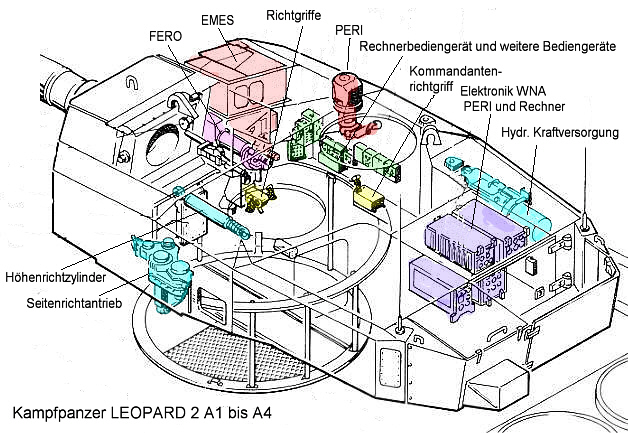
Technical Diagram of the EMES 15-09 sight inside the turret of a Leopard 2A1 (credits: KMW).
Active protection relies on two groups of four Wegmann 76 mm smoke mortars, mounted on either side of the rear of the turret sides. They can be electrically fired as single shots or in salvos depending of the threat. They could create usual white concealment smoke cloud but also flares and IR-disruptive smoke. Dutch models have a different configuration with only two banks of three pairs of mortars and the Swedish Strv 122 that uses the French GALIX system also shared by the Leclerc.
Modifications following the introduction of the 2A5/A6: Both models received additional armor added to the turret front, up to 920–940 RHAe on the turret, 620 RHAe on the glacis and lower front hull against kinetic projectiles. Spall liners are standard. The Canadian Leopard 2A6M CAN were given slat armor in complement against RPGs.
Armament
Main gun
The very essence of the Leopard 2 is centered around its Rheinmetall 120 mm smoothbore gun, of the same type also used on the M1 Abrams today. Basically up to the 2A4 it is known as the L44 and after (2A5/2A6) the "long barrel" L55 variant, that adds 1,30 m of extra barrel length. The latter of course adds an extra speed to the fired ammunition, thus enabling a far greater range and better penetration power. Both are fully stabilized, allowing fire on the move, with a +20° to −9° elevation/depression. The L44 and L55 has a bore evacuator and a glass-reinforced plastic thermal sleeve for regulating the temperature of the barrel. The barrel itself has a chrome lining for extra durability.Ammunitions
This gun can fire the German DM43 APFSDS-T anti-tank round, (penetration value 560 mm (22 in) at 2,000 meters (2,200 yd)), and the German DM12 multipurpose anti-tank projectile (MPAT). The L55 gun could fire a specially developed APFSDS-T round, the DM-53, which has a penetration value of 750 mm at of 2,000 meters. 27 rounds are stored inside a special magazine in the forward section of the hull, left of the driver, while 15 rounds more are stored in the left side of the turret bustle, separated by an electric door for safety. Indeed, in case of hit, blow-off panel vents off most of the blast upwards, preserving the fighting compartment. In addition Rheinmetall developed an upgrade for the barrel, allowing it to fire the LAHAT ATGM. The missile can engage targets well out to a range for an normal ammunition, in the order of 6,000 metres (20,000 ft).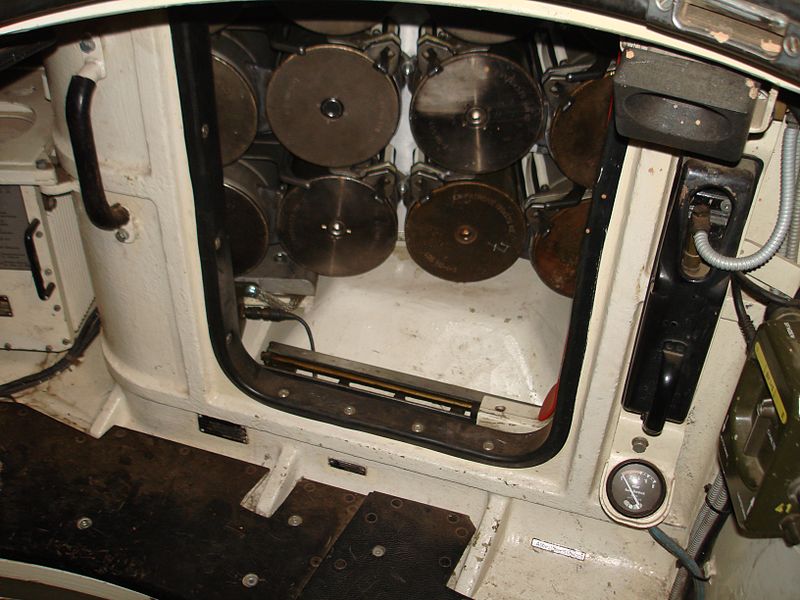
Leopard 2A4 ammunition storage.
Secondary armament
Two light machine guns are fitted as standard, the coaxial and the external auxiliary mounted on the TC ring mount. On German models, these are Rheinmetall MG 3 7.62 mm machine gun (developed from the WW2 MG42), whereas on the Dutch and Singapore models, these are replaced by FN MAG General Purpose Machine Guns (GMPG), of 7.62 mm calibers, and locally-manufactured MG 87 on the Swiss Leopard, of 7.5 mm caliber. 4750 rounds are carried on board to supply those.Fire Control System
The eyes of the Leopard 2 are improved compared to the former. The standard FCS is the German EMES 15 primary sight which has a dual magnification and is fully stabilized, had an integrated neodymium yttrium aluminium garnet Nd:YAG laser rangefinder, with a 120 element Mercury cadmium telluride, HgCdTe (also known as CMT) Zeiss thermographic camera. Both systems are linked to the tank's fire control ballistic computer. As a backup there is height magnification auxiliary FERO-Z18 gunner's scope mounted coaxially. The commander has his own independent Rheinmetall/Zeiss PERI-R 17 A2 periscope which is stabilized and designed for day/night observation and target identification. It is fully traversing. The thermal image is then displayed on a monitor in front of the TC. Temporarily the first batch only possessed a PZB 200 low light TV system (LLLTV).This fire control system provides up to three range values for each 4 seconds and the data is transmitted to the computer, which in turn calculate in real time the firing solution. The laser rangefinder isalso integrated into the gunner's primary sight, and therefore the gunner is able to read directly the digital range measurement. The computer deals with environmental condition (wind, temperature, humidity) chooses the right ammunition and automatically lays the gun to the correct trajectory. The maximum range of the laser beam is short of 10,000 m. Its measuring accuracy is less than 20 m at this range. The Leopard 2 can engage moving targets at up to 5,000 meters whilst being on the move over rough terrain at full speed and in all visual conditions. This system also enables a hunter-killer mode.
Camouflage and liveries
Due to NATO standards and the theaters of operations where the Leopard 2 operates which are mostly temperate, Europeans, all are normally factory delivered with an olive green primer. Early tanks, Danish, Belgian and Spanish Leopards were left in this primary livery. In the 1980s however, NATO standard introduced the regular three-tone camouflage used by continental tank, made of dark green and light maroon wavy spots on the primer. In winter, a provisional washable white paint was applied for maneuvers, in wavy striped and spots. More recently, the Greek 2A6 showed by far the most singular camouflage, made of light reddish maroon, beige, olive green, and black. More recently, KMW released the 2A7+ intended for the middle east and painted with a beige primer, pink and light olive spots. Another one was designed for urban warfare, equipped with a dozer blade and painted with the dedicated checkerboard pattern of light blue, dark grey, pale and medium grey, and pinky beige.Production of the Leopard 2
In 1977 the decision was made under the MoD to procure 1,800 Leopard 2 main battle tank to the Bundeswehr. Krauss-Maffei AG was chosen as the general contractor, but in addition, Krupp-MAK in Kiel was involved for 45% of production, as well as all their sub-contractors and suppliers. In the spring of 1977, comparative testings of the two eligible FCS (Fire Control Systems), the American Hughes and the German AEG-Telefunken were compared. Both were found technically on the same level but at the end the decision was favorable to the Hughes system for the series vehicles. On 11 October 1978, the first definitive pre-series vehicle was delivered, and three more followed in the first half of 1979. This early first batch was characterized by a newly designed operator's platform and modified tracks (longer glacis plate and a new arrangement for the return rollers). Tests led to the adoption of further modifications into the first batch. The fourth of the series was handed over on October 24, 1979 with an official ceremony and live demonstration with infantry. This was the only one in service, while the first three remained at the testing ground for further testings.From the 29th vehicle the cooling air outlet grilles were strengthened. Mass production was now at a full swing, and Krauss Maffei was ready to establish the definitive series from these 30 vehicles. The next batches were height in total although five were initially planned.
The first batch of 200 (October 1979 - March 1982) comprised these items, which were upgraded on the next ones:
- EMES 15, main periscopic sight with integrated night vision.
- Laser rangefinder
- PERI R17 TC panoramic day view periscope
- FERO Z18 turret main gun sight for the gunner
- WNA H22 electro-hydraulic gun laying and stabilization system (Waffennachführanlage)
- Hugues Fire control system
- Cross-wind sensor on the turret roof
- RPP 1-8 ballistic computer and tester
- Image Intensifier PZB 200 (Thermal imaging not yet available)
- Side-mounted side skirts
Until 1992, the Krauss-Maffei eight batches represented no less than 2,125 Leopard 2 in different versions (from A0 to A4) for the German army. MaK was responsible for the final assembly of the Leopard 2 under supervision of Krauss-Maffei. Blohm + Voss built the main hull and compartment cells, Henschel Defence Technology (now Rheinmetall Landsystems) built the turret, but Rheinmetall DeTec and Wegmann & Co. (today KMW) were charged of the 120 mm gun and the turret sub-assemblies and fittings. ZF Friedrichshafen, MTU and Diehl Remscheid were in charge of the powerplant, gearbox and tracks. The fire control system and main target sight came from STN Atlas Elektronik in Bremen while Carl Zeiss provided the tank commander peripherical periscope.
Variants
Leopard 2
The basic version, this model is sometimes designated "A0". This first batch of 380 was built from October 1979 to March 1982 (209 by KMW and the others by MaK). These were characterized by the followings:- Electrical-hydraulic WNA-H22 system
- Fire Control System & Ballistic computer
- Laser rangefinder
- Wind sensor
- General purpose EMES 15 periscopic sight
- Panorama periscope PERI R17
- Turret roof main sight FERO Z18
- Computer controlled tank testing set RPP 1–8
- 200 of the vehicles had a
- Low-light enhancer (PZB 200) rather than a thermal imaging for 200 of these
Leopard 2A1
Second batch, of 450 vehicles (248 by Krauss-Maffei (Chassis Nr. 10211 to 10458) and 202 by Mak (Chassis Nr. 20173 to 20347)), with deliveries starting in march 1982, until november 1983. The Gunner's thermal sight installation was modified and improved as well as the ammunition racks (identical to those in the M1 Abrams) and redesigned and optimized fuel filters (for faster refuelling). Another batch of 300 (165 by Krauss-Maffei and 135 by MaK) followed between November 1983 and November 1984, including minor changes, later retrofitted to the earlier models.Leopard 2A2
This designation was only given to the upgraded first batch brought up to the standard of the second and third batches (2A1). The PZB 200 sights were replaced by Thermal sights EMES 15, filler openings and caps (forward fuel tanks) to do separate refueling, deflector plate for the periscope, and cover for the NBC protection system. New 5 m steel towing cables were also added and relocated. This modernization lasted from 1984 to 1987.Leopard 2A3
This fourth batch comprised 300 vehicles (165 by Krauss-Maffei and 135 by Mak) delivered between December 1984 and December 1985. They are only marked by the addition of the SEM80/90 digital radio sets (also retrofitted on the Leopard 1), and the ammunition reloading hatches welded shut.Leopard 2A4
The most important variant in quantity and amplitude of changes. It surpassed by far all other variants by numbers alone, with more than 1,800 built in eight batches between 1985 and 1992. This became also the new standard for upgrade for former version. By 1994, more than 2,125 German Leopard 2 in service were of this type, including former series upgraded to this standard. Among these changes are the addition of an automated fire and explosion suppression system, all-digital FCS (which can preset the new ammunition types), as well as armor modifications on the turret, with improved flat titanium/tungsten sets in standard. An additional batch of 445 tanks was also produced for the Netherlands. It was also manufactured under licence in Switzerland. However after the end of the cold war, important stocks of German and Dutch Leopard 2A4s were sold, which is why this is the most well-known and common version internationally, and several modernization packages and programs were made for it until recent years.Leopard 2A5
The 2A5 (introduced in mid-1998) is externally the easiest to distinguish from previous versions, introducing a wedge-shaped spaced add-on armor covering the frontal area and forward sides of the turret. These modules can defeat a hollow charge before it reaches the base armor, as well as deflecting and eroding kinetic-energy penetrators. The shot-trap effect was studied and evaded due to the first layer which does not deflect the penetrators on sensitive areas, including angle calculations and the material used for the most outer skin. The gun mantlet was therefore redesigned to to fit in. In addition the whole armor composition was upgraded.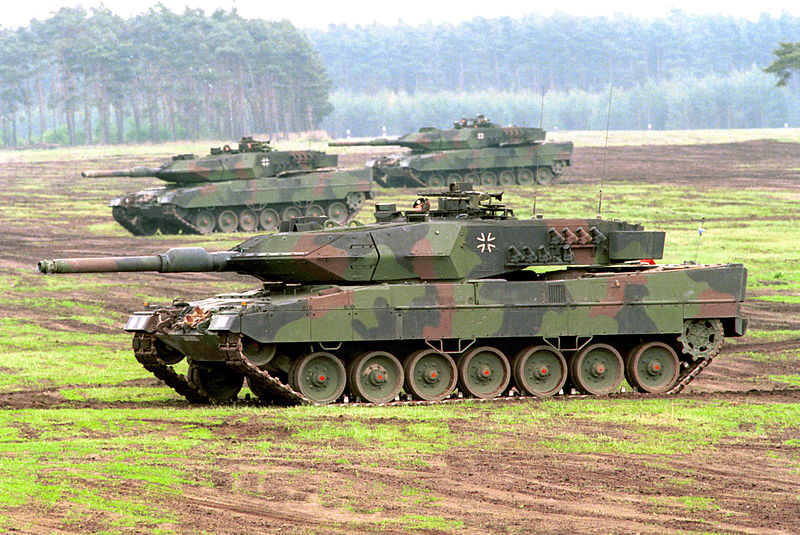
Spall liners were introduced into the crew compartment to reduce fragmentation, and the frontal section of the side skirts was upgraded and made stronger. The turret traverse and systems were all made electric to save weight and simplify maintenance and reliability. The TC sight was moved behind the hatch, and an independent thermal channel was added. The gunner's sight was also moved to the turret roof (in former versions it was integrated into the cavity in the front turret armor). The driver's hatch was also modified.
Since this version was prepared to be upgraded to the new L/55 120 smoothbore main tank gun developed by Rheinmetall, the whole gun braking system was improved in advance. It already enabled to fire more powerful ammunition on the L/44 gun like the DM-53 APFSDS.

Leopard 2A6M from the Bundeswehr
Leopard 2A6 and 6M
Also named the "long" Leopard 2, it is essentially similar to the 2A5 but integrates the new Rheinmetall 120 mm L55 smoothbore gun. Much longer, this version enable not only to fire heavier ammunition but also increased muzzle velocity, range and accuracy. Otherwise there are only minor upgrades. The Leopard 2A6M introduced an enhanced mine protection system under the belly, and internal enhancements to improve crew survivability.Leopard 2PSO
The PSO was developed by KMW as a specialized urban-combat proven vehicle (The PSO stands for Peace Support Operations), urban warfare, after the experience of deployment in the Middle east. The PSO package aimed at a more effective all-around protection. There is a secondary (remote) weapons station, better awareness due to multiple close-range cameras, a bulldozer blade, a shorter gun barrel as well as non-lethal armament and a searchlight as well as some minor armor change to protect against unusual angles (specific to an urban environment). Some of these features are reminiscent of the American TUSK system. It was displayed at Eurosatory 2008 and the following years but no order came.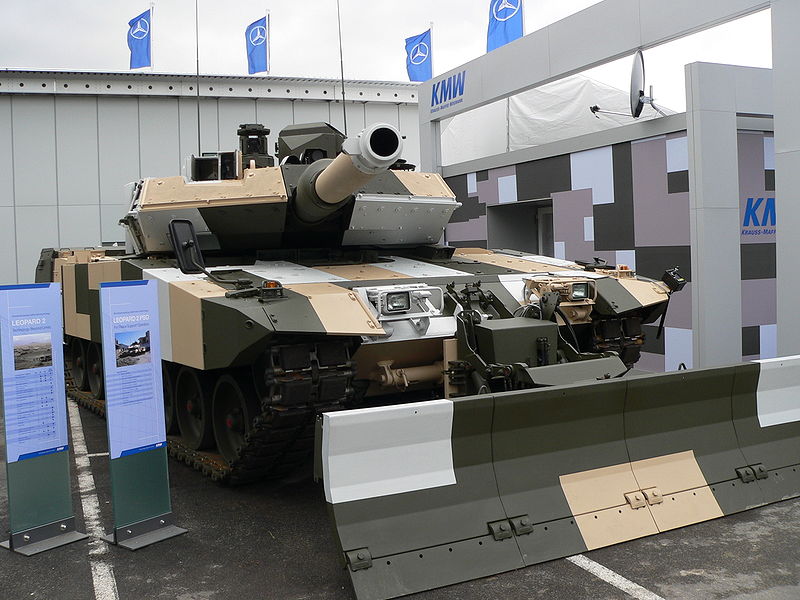
Leopard 2PSO at Eurosatery 2010
Leopard 2A7 & 2A7+
The Leopard 2A7 concerned only a total of 20 vehicles provided by Canada (Former Dutch A6NL returned from Canada to Germany). This was an upgrade to the A6M level in coordination with Canada and comprising an air-conditioning system, Steyr M12 TCA auxiliary power unit, Barracuda camouflage system (heat transfer) IFIS digital combat system, onboard network optimization (ultracapacitors stored in the chassis and turret), SOTAS IP digital intercom, upgraded fire suppression system and TC's Attica thermal imaging module. On December 10, 2014, the first were received at the Munich base, 14 for the Tank Battalion 203, and the others to the Armoured Corps Training Centre and Technical School for Land Systems/Technology of the Army.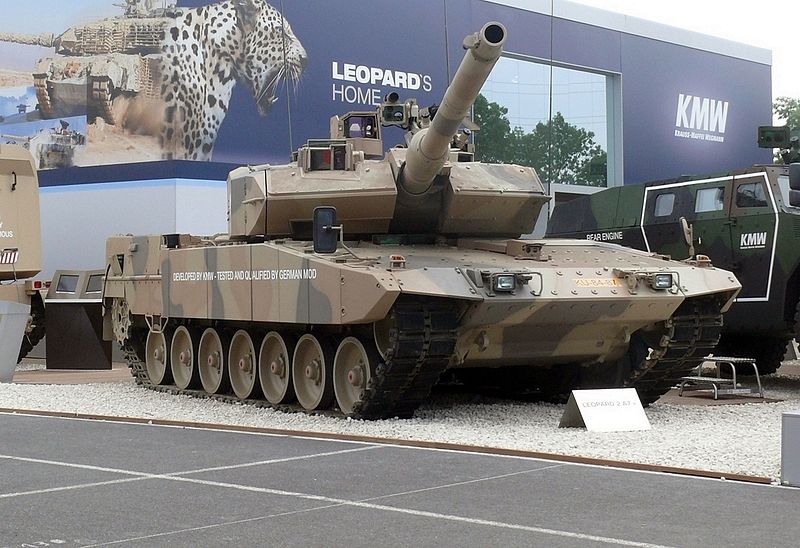
Leopard 2A7+ at Eurosatory in 2010
The Leopard 2A7+ (first shown at Eurosatory 2010, was tested by the Bundeswehr as the UrbOb (urban operations) concept. It is designed to operate in low intensity conflicts which can degenerate into high intensity. The protection includes new modular armor modules, frontal protection (dual-kits) and all-around protection against RPGs, mines and IEDs. The A7+ can fire programmable HE munitions. The MG3 was replaced by a remote-controlled and fully stabilized FLW 200 weapon station. The mobility and situational awareness were also upgraded to the same lines as the 2PSO. No order has been recorded yet for this model.
Leopard III/Leopard 2-140 (project)
Back in the fall 1980s Rheinmetall developed a 140 mm smoothbore cannon for future needs as it was expected that the next-generation Soviet main battle tank would be armed with a 135 mm/152 mm main gun. This program came also as a possible future replacement for Leopard 2 and modernization program. Called KWS III this program called for the development of a new turret compatible with the 140 mm smoothbore cannon, with the addition of an automatic loader, complete with a lateral loading system and therefore the main gun offset to the left. The 32 rounds were stored in a large ammunition storage which covered all the turret rear. Protection level was to be at least equivalent of better than on the Leopard 2A5 and command and control improved by the latest iteration of the ISIS battle system. Although this program was not chosen development on the gun resumed, with live trials with a modified Leopard 2, with the smoothbore gun just fitted with counterweights. Although tests shown an undeniable hitting power, difficulties erupted soon with the handling and the lack of autoloader did not helped.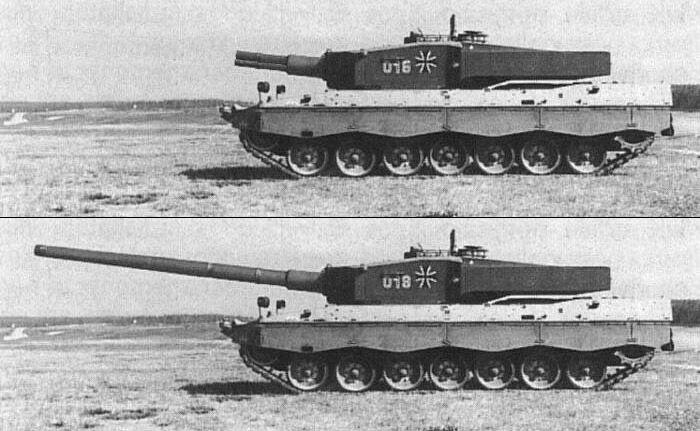
Leopard III prototype, armed with a 140 mm smoothbore cannon
Derivatives
Bergepanzer BPz3 Büffel (1988)
Studies for a recovery vehicle intended to salvage the Leopard 2 commenced in 1986. it was to succeed to the Bergepanzer 2A2 based on the Leopard 1 in 1977. Three prototypes has been built in 1987, followed by the definitive version in 1988. The ARV (Armoured Recovery Vehicle) version includes an hydraulically-assisted bulldozer blade at the front, plus a crane with integral winch of 30 tons capacity placed on a jib that can traverse 270°, and to its left hand side, the superstructure for the crew of two (driver, TC) with an extra seat. There was also a MG3 machine gun for self-defense, plus a set of smoke grenade launcher for self concealment. Other particulars are identical to the Chassis (NBC, amphibious capabilities, night sights, fire extinguishers...).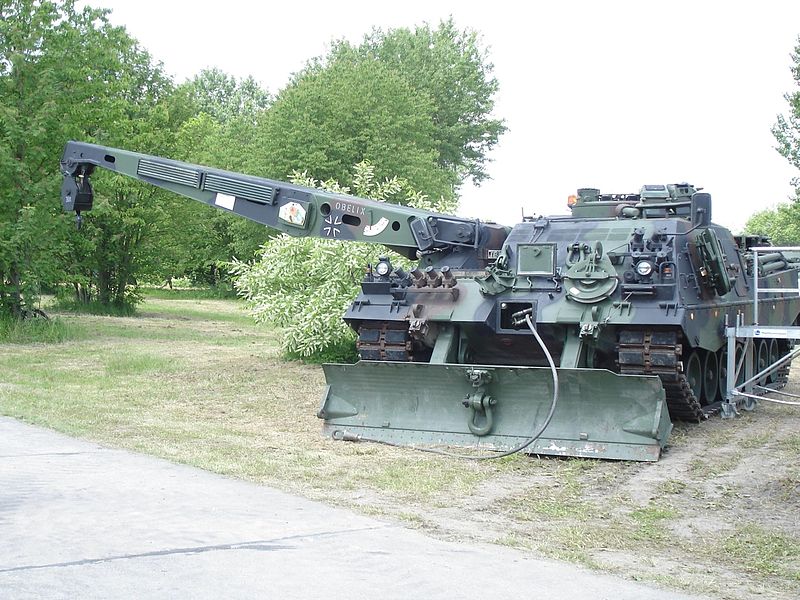
This model entered service with the German Bundeswehr (75) in 1990, the Netherlands (25 Bergingstank 600 kN Bueffel - The Netherlands participated in its development), Austria, Canada, Greece (12), Singapore, Spain (16 Leopard 2ER Buffalo), Sweden (14 modified Bgbv 120), and Switzerland (25). production was shared between MaK Systemgesellschaft mbH in Kiel, the main contractor (55) and karuss-Maffei (45). The Buffel is a 54 tons tanks, and a towing capacity of 62 tons. It can speed up to 68 kph with a range of 680 km. Its components are also shared with the South Korean K1 ARV, and French & UAE Leclerc ARV.
Panzerschnellbrücke 2
MAN Mobile Bridges GmbH developed an armoured vehicle-launched bridge on the Leopard 2 tank chassis. It is of the folding mobile bridge system, quickly "launched" across any river and sturdy enough to support the crossing 70 tons vehicles. The bridges are simply hooked up and re-stowed after usage. This model serves with the Bundeswehr but was ultimately replaced by the more versatile Leguan.Panzerschnellbrücke Leguan
Also called Modular Bridge System (PSB2), this impressive vehicle was developed for the Netherlands and German Armies by MAN Mobile Bridges GmbH. The Leguan is holding three bridges and their modules, 9.7 meters each. Several different combinations of bridges are therefore possible on the spot. There is a crew of two, the driver and operator that could laid the bridge in 5-6 minutes on average. Each bridge section is 4 m wide of 65 cm in height 5 tons. Their maximal carrying capacity is intended for the MLC 70 Standard and MLC 100 in caution Crossing for wheeled vehicles. 35 were delivered to the German Bundeswehr and 14 for the Netherlands Royal Army.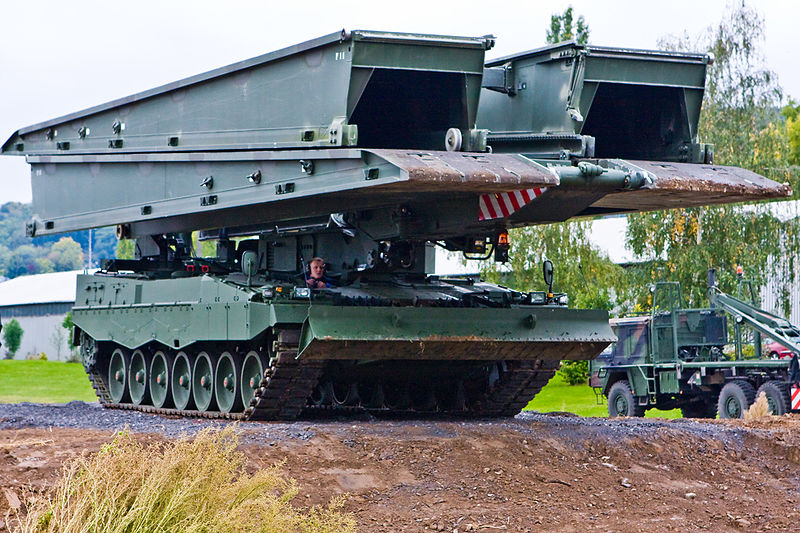
Pionierpanzer 3 Kodiak
This CEV (combat engineering vehicle) Kodiak or Pionerpanzer 3 is a conversion of the Leopard 2 chassis used by Swiss, Dutch army and Swedish armies. They share a bulldozer blade powered by hydraulic arms, an excavator, and dual 9 tons capstan winches for a maximal towing capacity of 62 tons. the Pionierpanzer 3 relies upon a Remote Weapon Station with the MG3 LMG for self defense. It has a crew of two (driver/operator) inside a built-up forward superstructure. The Kodiak can be used for clearance of obstacles, mine warfare, building of structures, relief in disaster areas. The Dutch version have an additional bomblet protection to protected the crew compartment. 24 more are intended for the Spanish Army, converted from retired surplus Leopard 2A4 hulls.Others
Other conversions includes a driver Training Tank (Fahrschulpanzer), non-armed, turret-less, but with a weighted and fixed observation cab; but also the Leopard 2R Heavy mine breaching vehicle (developed by Patria for the Finnish Army), Leopard 2L Armoured vehicle-launched bridge (KMW and Patria also for Finland), and the WISENT 2 Armoured Support Vehicle developed by Flensburger Fahrzeugbau, consisting of a fast conversion kit from an ARV to a CEV and vice versa.Exports: The "Euro-Leopard"
Future historians will probably see the first European MBT as being the Leopard, adopted by all nations but the two, ironically that pioneered the concept: Great Britain and France. Although Italy locally produced the Leopard 1, it was later derived into the national MBT Ariete. The Leopard 2 was equally succesful in this matter, and even more than the 1st of the felines (16 and perhaps soon 18 versus 14). The very same countries that adopted the first, purchased the second (but Australia).Europe
Austrian Leopard 2s:
114 Leopard 2A4s were acquired from surplus and one turret for training. In 2014 only 56 remained still in service due to drastic budget cuts and the remainder possibly re-sold to KMW.Denmark:
57 Leopard 2A5DK (same as the Leopard 2A6 but with the L44 gun, along with several small modifications) and 6 Leopard 2A4 for spares.Finland:
124 2A4s purchased from surplus stocks in 2003, 12 later converted into bridge layers and ARVs. 12 disassembled for spares. 15 more 2A4s for spare parts were purchased in 2009. 139 total. Plus order for 100 2A6NL more to the Netherlands in jan. 2014.Greece:
353 Leopard 2 in all: 183 ex-German 2A4s and 170 new Leopard 2A6 HEL for export. The Leopard 2 Hel was tailored for Greece as a derivative of the 2A6, ordered in 2003. 170 tanks were delivered between 2006 and 2009 plus 140 more built in Greece by ELBO, starting in late 2006.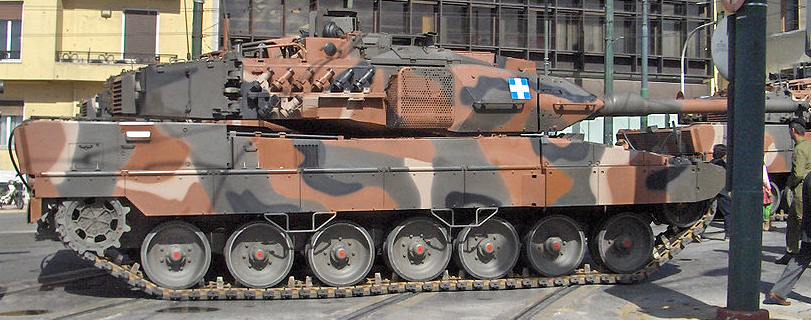
The Netherlands:
445 Leopard 2s were ordered and operated, of which 330 updated to the 2A5 standard in 1993, and 188 of the the latter were upgraded to the 2A6 standard (2A6NL). On April 2011, the Dutch Ministry of Defense announced the dissolution of the last remaining tank division and the remaining tanks sold. Possible customers included Indonesia (blocks by the parliament) and Bolivia (in 2013, disqualified due to logistical complexities.), but Finland signed a deal in January 2014 for €200 million with deliveries planned from 2015 to 2019. In early 2015 however the Dutch government back down and decided to maintain at least an instruction tank company of 18 tanks.Norway:
The Norwegian Army operates 52 (ex-Dutch) Leopard 2A4s, known as the A4NO, and being upgraded to the 2A5 standard.Poland:
128 Leopard 2A4s were already ordered in the 2010, with a further 14 2A4 and 105 2A5 in March 2013. In March 2013, it was decided to establish a second brigade with the same composition. Upgrades to the Leopard 2PL standard are just started. The First eleven Leopard 2A5s were in service by May, 16, 2014.Portugal:
37 ex-Dutch Leopard 2A6s were purchased in the 2010s and are currently in service.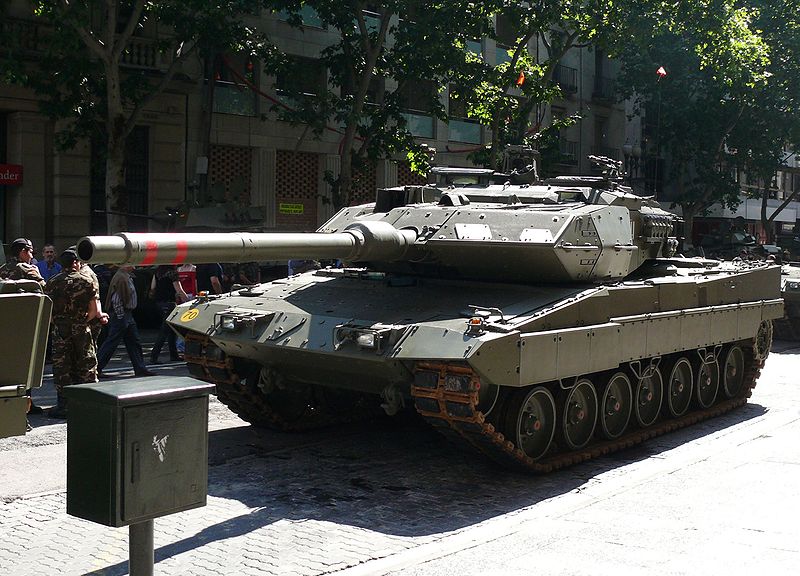
Spain:
The Ejercito Real operates 327 Leopard 2s in total, among these 108 2A4s from German stocks and 219 purpose-built 2A6+ which are known as the Leopard 2E. Comparative tests were be conducted by the Peruvian Army with these but the deal was declined in 2013. The Leopard 2E is known to have a greater armor protection than the 2A6, developed under a joint German-Spanish development program decided in 1995. For this, 108 Leopard 2A4 were detached for five years from the German Army, later extended up to 2016, with a full acquisition afterwards. A contract for 219 Leopard 2Es was accompanied by 16 Leopard 2ER Bufalo ARVs plus 4 training tanks. Santa Bárbara Sistemas is responsible for the upgrades, integrated logistical support, training for instructors and maintenance personal as well as simulators (2004 - 2008).Sweden:
The Swedish Army acquired 120 Leopard 2(S) also known locally as the Strv 122. 160 2A4s were also leased by the German Army as the Strv 121, but these are no longer in service. The Leopard 2(S) are an export variant of the Leopard 2A5, also locally designated Strv 122. It is based on the "Leopard 2 Improved" featuring increased armour on the turret top, front hull, but also improved command & control and FCS. In addition is received the French GALIX smoke dispensers, reworked storage bins, and reinforced crew hatches. The Strv 122B variant is equipped with the modular AMAP composite armor (manufactured by IBD Deisenroth) providing an all-around protection against EFPs, RPGs and IEDs. This package add some 350 kg (770 lbs) to the armor.
Switzerland:
380 2A4s (known locally as the Pz 87 were purchased). On this total only 35 were purchased from Germany while the remainder were built locally under license. 134 were modernized in 2006, 42 were sold back to Rheinmetall and 12 converted into mine-warfare and CEVs. Others are in storage. The Panzer 87WE (for "WertErhaltung") is a protection improvement that comprises the new 2A6M mine protection kit, a thicker front glacis, and Swiss-developed titanium alloy composite modules on the turret. Smoke grenade launchers are also redesigned, turret electric drive is similar to the Leopard 2A5, there is a driver rear-view camera, independent weapons station for the loader, plus improvements on the C&C and FCS. The latter uses a Carl Zeiss Optronics GmbH PERI-R17A2. In option, a remote-controlled, fully stabilized Mg.64 12.7 mm (0.5 in) HMG could be fitted onto the roof. The Pz 87-140 was the equivalent of the Leopard 2 prototype with a 140 mm gun and tested the additional armour later adopted.The rest of the world
Canada:
100 Leopard 2A4 were acquired from the Netherlands. In 2007, twenty 2A6M were leased by Germany to support the Canadian operations in Afghanistan, along with 2 Bergepanzer 3 Büffel. 15 more Leopard 2A4 tanks were purchased for spare parts and 12 ex-Swiss Pz 87 were purchased in 2011, and stocked for conversions. The actual Canadian Leopard 2s park consists of 59 1A4s, 2A4M CAN and 2A6M. The first is and upgraded local version of the ex-Dutch Leopard 2A4 and specially designed for Afghanistan theater of operation. Deliveries started in October 2010, 5 being deployed at end the year, operating with success until July 2011. These tanks retained the "short barrel L44" as being more compact for use in urban conditions. Slat armor was added in some places only, with the addition of applique armor (close to the one use on the Leopard 2A7+).Chile:
132 Leopard 2A4s were purchased in 2007 and later upgraded to the 2A4CHL standard (and 8 for spares), all from German stocks. In April 2013, after negotiations, Chile began to acquire 100 Leopard 2A5s from surplus German stocks and modernization kits for its 2A4s. The 2A4CHL is basically an upgraded 2A4, with new electronics, better sighting, sensors, data and battlefield digital management, up to the level of Leopard 2A6. In addition the suspension system is improved and the L55 version of the gun is also adopted as well as two remote weapon stations over the gunner and commander hatches (MG3 & HK GMG). The roof and side turret armour is improved.Indonesia:
The army obtained to purchase 103 ex-German 2A4s, along with 4 Büffel ARVs, 3 Leguan AVLBs and 3 Kodiak AEVs. Rheinmetall proposed and obtained in addition a contract for the upgrade of 63 2A4s to the 2A7+ Revolution standard, along with the delivery of 50 Marder 1A3 IFVs, with deliveries starting in September 2013.Qatar:
Negotiations with countries in the middle east has been tricky due to the severe restrictions over weapons exports from the parliament, depending on the nature and actions of the regimes. Negotiations with Saudi Arabian are landlocked since 2013 (62 and later 200 Leopard 2A7+). However for Qatar, the German Bundessicherheitsrat ratified the agreement, and 62 Leopard 2A7+ are to be delivered from 2015 to 2018.Singapore:
The Singaporean Army purchase 96 ex-German stocks Leopard 2A4s, including 30 for spares. Upgrades with AMAP composite armor in 2010 were also obtained, by IBD Deisenroth and ST Kinetics. These new Singaporean tanks were renamed Leopard 2SG in October 2010. 182 Leopard 2A4s in total had be delivered as of 2013.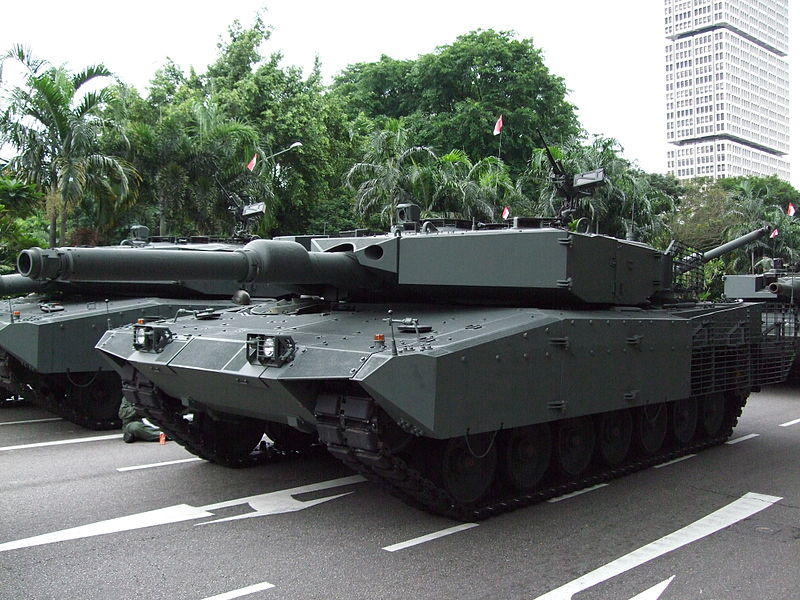
Turkey:
The Turkish Army ordered and received 354 Leopard 2A4s in several batches from German stocks. Since then, a wide modernization program is currently under development by the local company Aselsan. These are of the same level as the Leopard 2NG (for New Generation), which also used IBD Deisenroth add-on armor packages seen on the Singaporian 2SG. This upgrade is privately funded by Aselsan (Turkey) including the application of modular composite armour (AMAP), upgraded optics, overhauled turret mechanics and a new FCS also developed for the local Altay MBT and for the modernization of the Turkish Leopard 2A4s. Both the engine and L/44 gun are kept, although the overall weight rose to 65 tonnes.Operational History
Ex-Yugoslavia (1995-1997)
The Leopard 2 entered service in 1979 and rapidly replaced older tanks, including the earlier versions of the leopard 1. The only operational deployment of the tank was in Kosovo in the late 1990s for peace keeping operations with IFOR/SFOR. All German tank battalions of the "crisis intervention forces" are equipped with the A6s. Nowadays Germany operates around 2,350 Leopard 2s of all versions. But in order to reduce maintenance costs with the end of the cold war, nearly 90% of the leopards in reserve were sold reconverted, stored or scrapped, which left around 250 Leopard 2s in service as of March 2015. The Dutch Leopard 2s were also deployed in ex-Yugoslavia (Bosnia-Herzegovina), stationed in Bugojno, Novi Travnik, Sisava, Knezevo, Maslovare and Suica as a deterrent.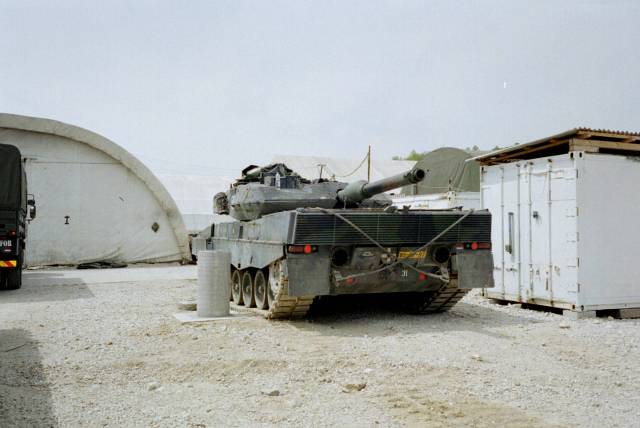
Afghanistan (2008-2013)
However the Canadian Leopards were the only ones deployed in an active combat zone, in Afghanistan in 2003 (ISAF). This was Operation Medusa, where alongside older Leopard C2s, a contingent of 20 Leopard 2A6s and three armored recovery vehicles directly leased from Germany were deployed in late 2007. The Lord Strathcona's Horse (Royal Canadians) unit was the first deployed. One Leopard 2A6M survived an IED explosion and several others dealt actively with Taliban ambushes. These tanks were fitted with a driver "Dynamic Safety Seat" for extra protection against mines.Denmark also deployed some of its 2A5 DKs in the same theater of operations in the same period, the Jydske Dragonregiment (Jutland Dragoons Regiment) supported by M113s. These Leopards were fitted with Swedish-made Barracuda camouflage mats that protected from the sun and reduced their HEAT signature at the same time. These tanks stopped a Taliban flanking maneuver in January 2008 when in support near the banks of the Helmand river, in co-op with British Infantry there. One tank was hit in February by an IED and had to be recovered and repaired. The driver was a fatality. In another case, there were no fatalities at all, and in both, the tanks were able to move out of harm's way. By December 7, 2008, Operation Red Dagger showed these Danish Leopards firing 31 rounds in support of Coalition troops in the process of securing the Nad Ali District. By 2013 when these tanks were retired official British reports were dythirambic about their efficiency and accuracy.
Sources/Links about the Leopard 2
The Leopard 2 on Wikipedia The Leo 2 on fprado Krauss Maffei official Leopard 2 page The Leopard 2 on Panzerbaer (German) The Leopard 2 (German) About the Leo 20-2A4 protectionKMW official promotional Video
Leopard 2 specifications | |
| Dimensions (L-W-H) | 9.66m (7.72 without gun) x 3.7m x 2.8m (31'7" (25'3") x 12'1" x 9'1" ft.in) |
| Total weight, battle ready | 62.3 tonnes ( ibs) |
| Crew | 4 (Driver, commander, gunner, loader) |
| Propulsion | MTU MB-837 V8 diesel 2.9L 1800 hp (368 kW) |
| Suspension | Independant torsion bars |
| Speed (road) | 70 kph (43,5 mph) |
| Range | 385 km (239 mi) |
| Armament | Main : Rheinmetall xxx L/44 120 mm Sec. 2 x 7.62mm MG3 machine guns |
| Armor | 50 mm front and sides (?? in) A4 |
| Total production | Current. 3850 since 1978. |
Gallery
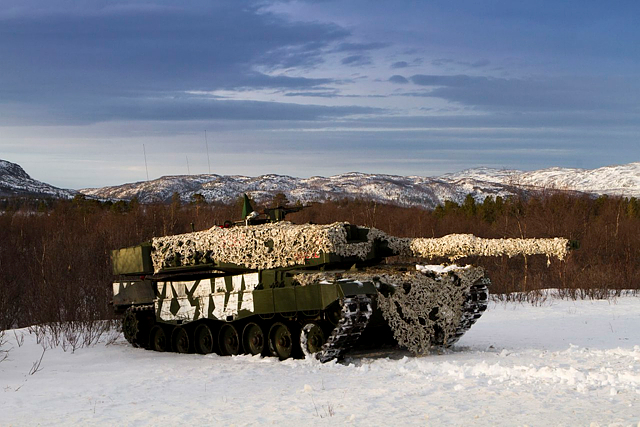
.jpg)
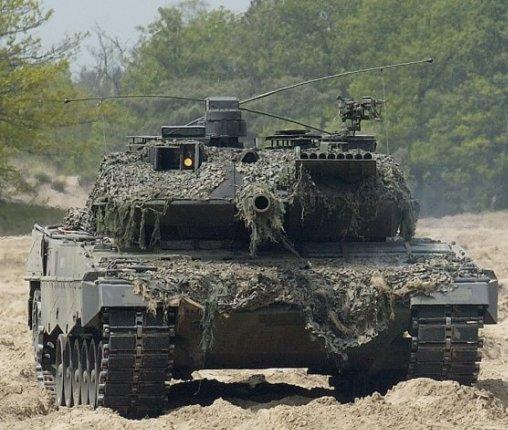

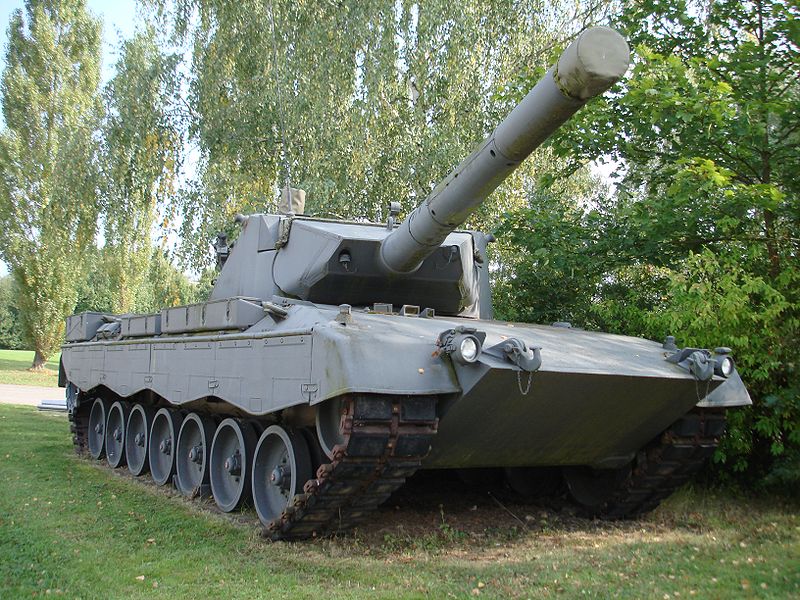
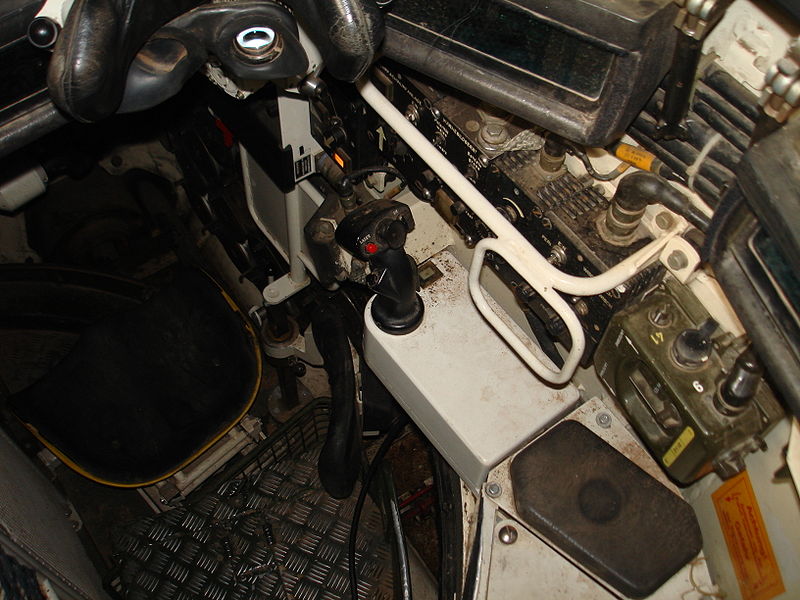
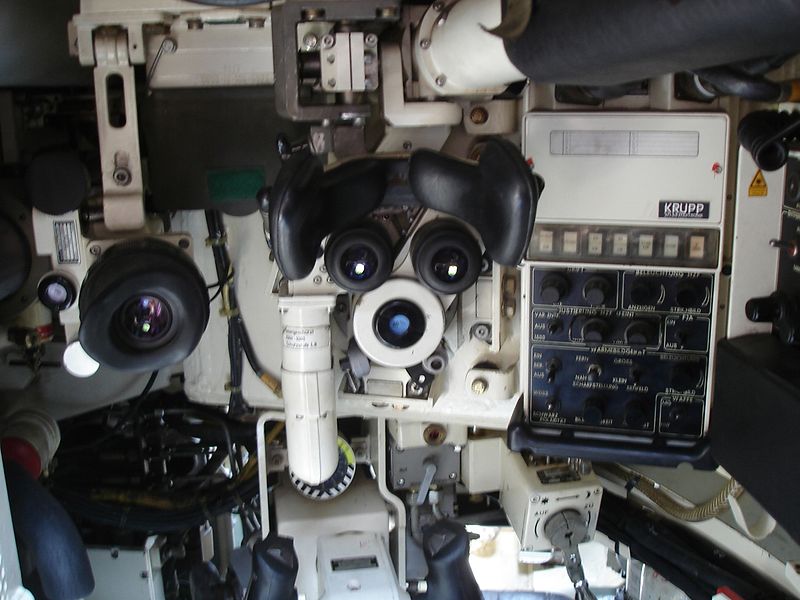
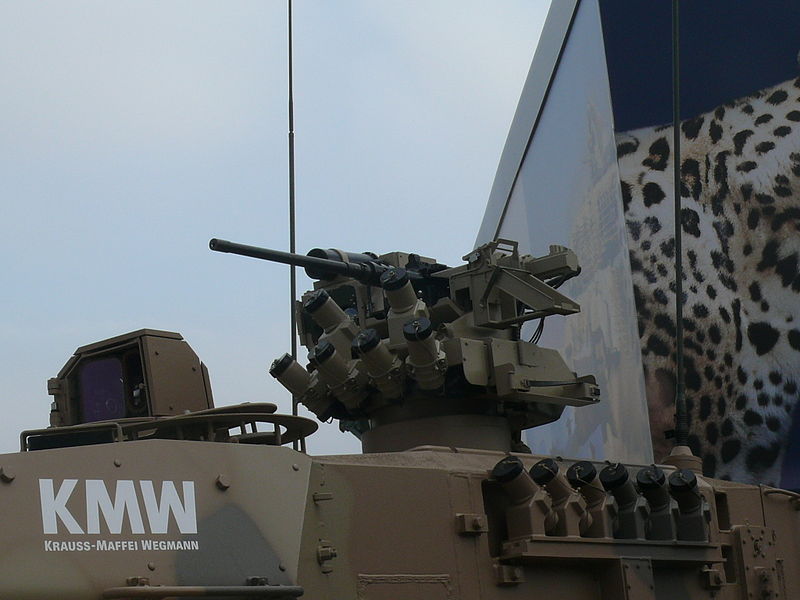
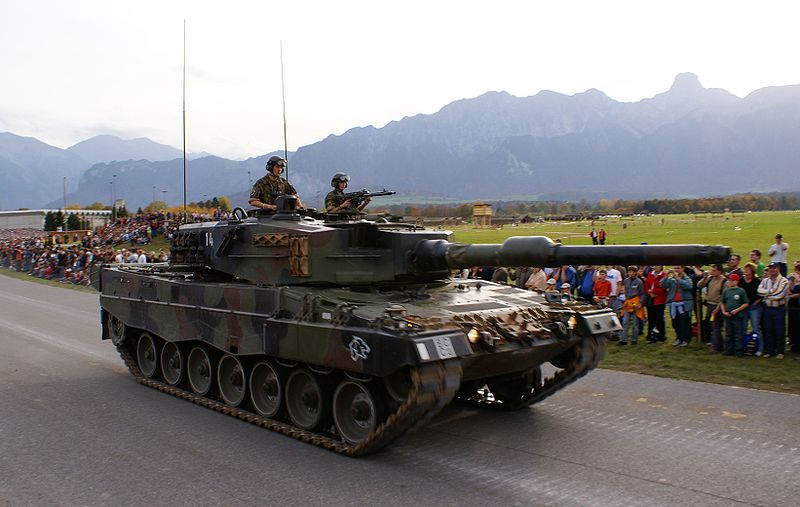
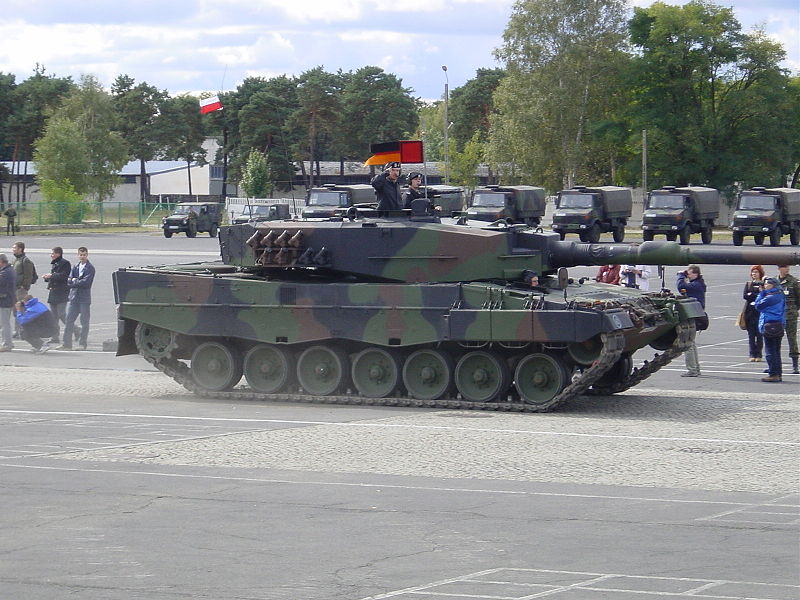
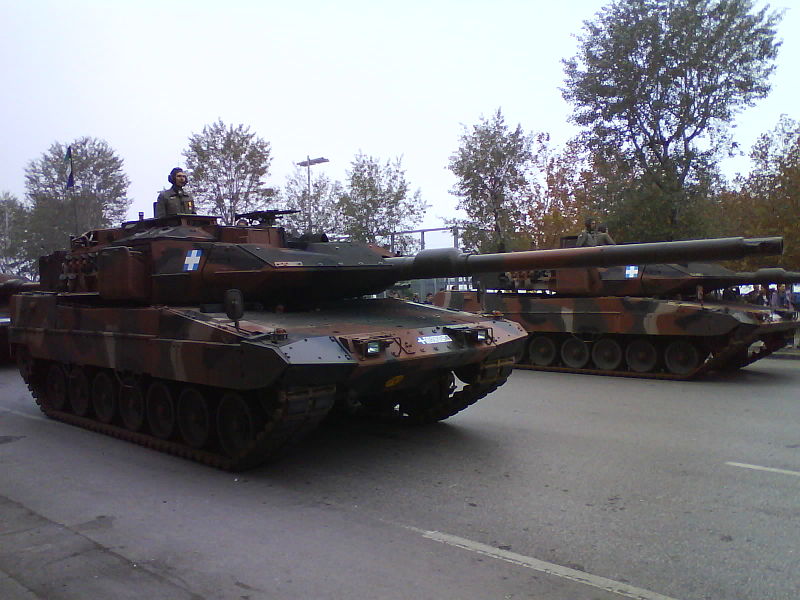
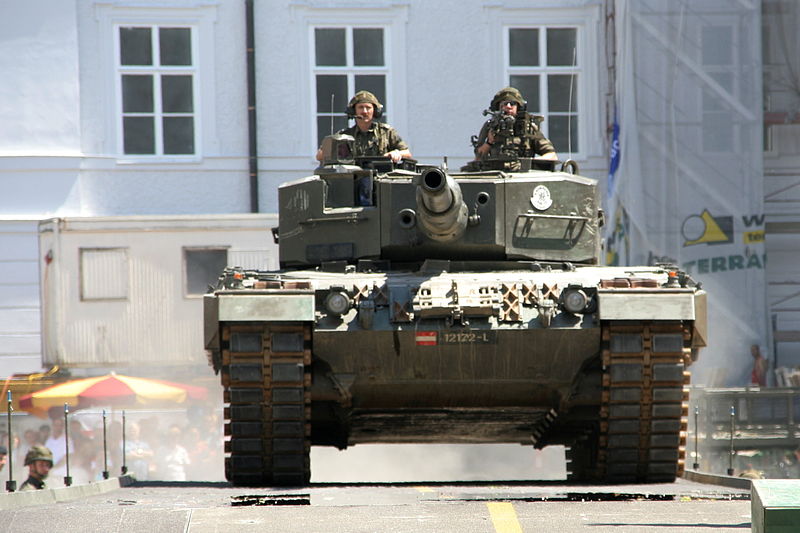
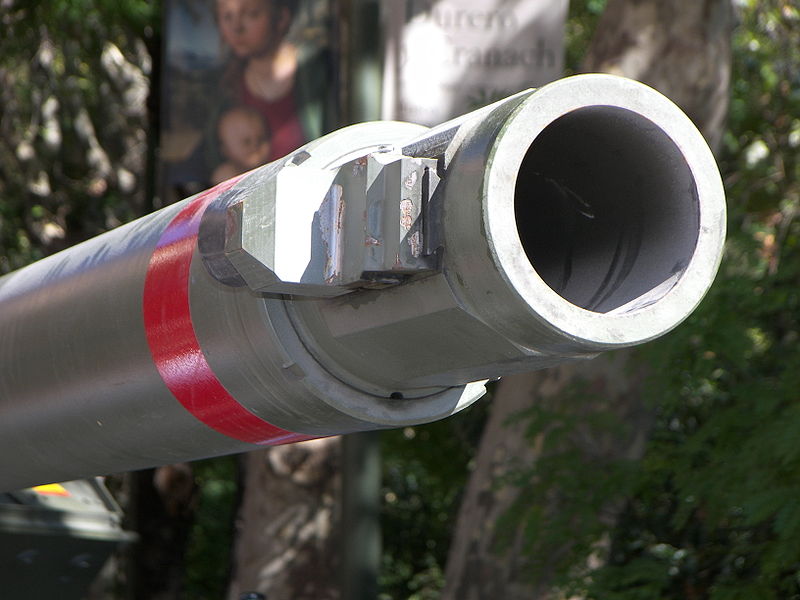
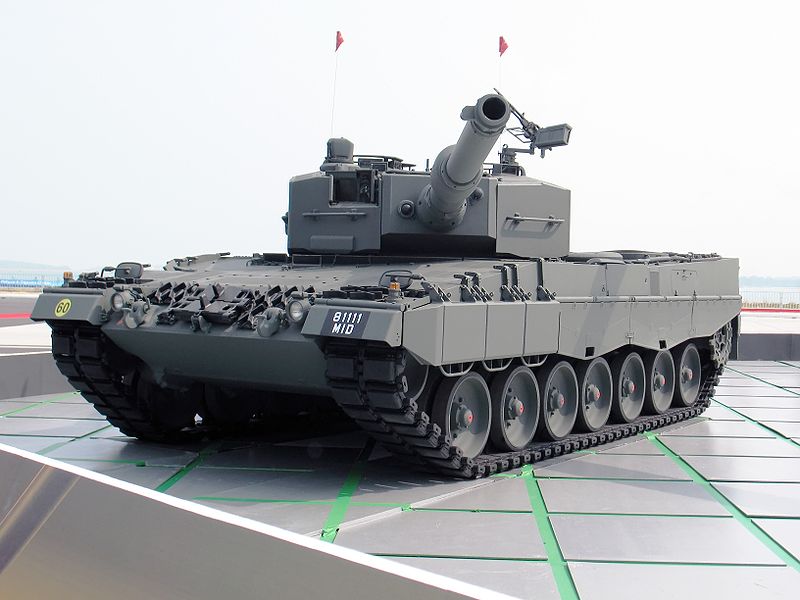
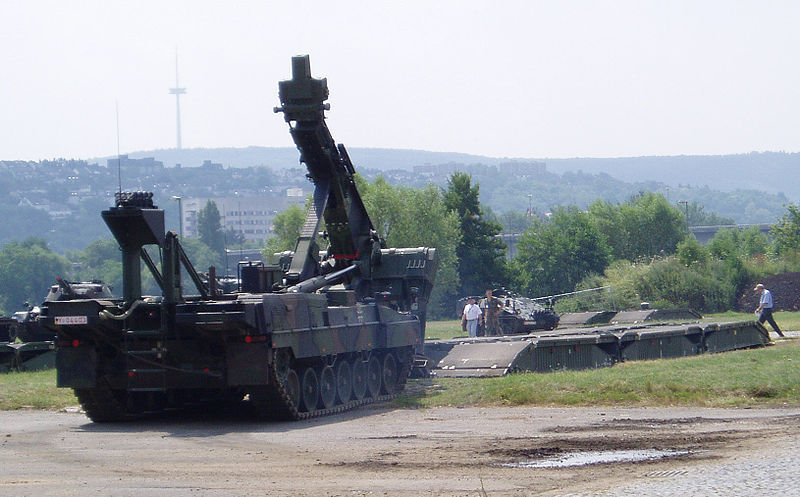
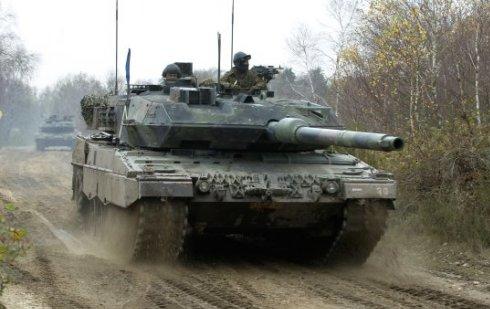
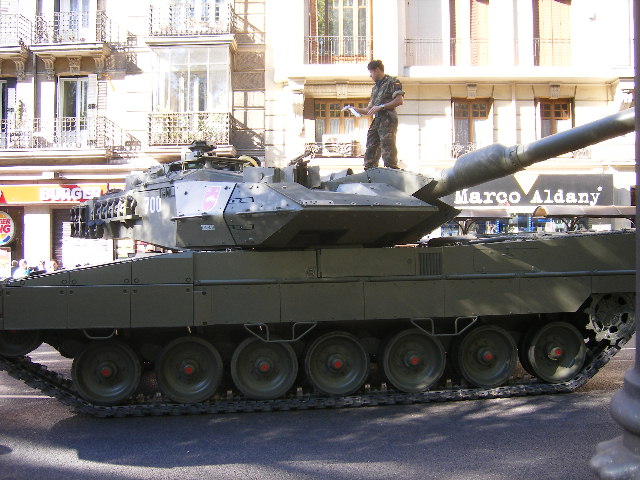
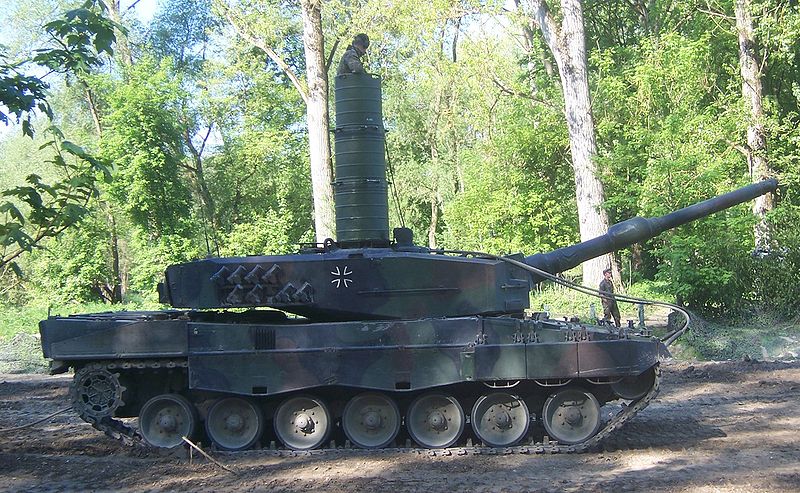
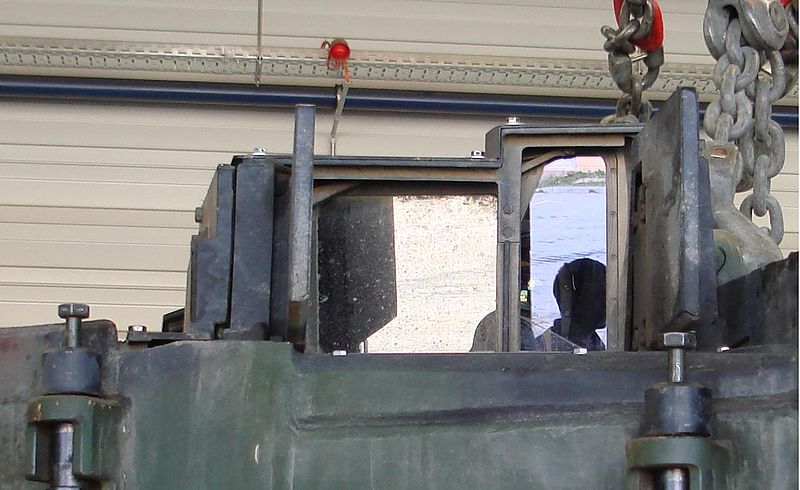
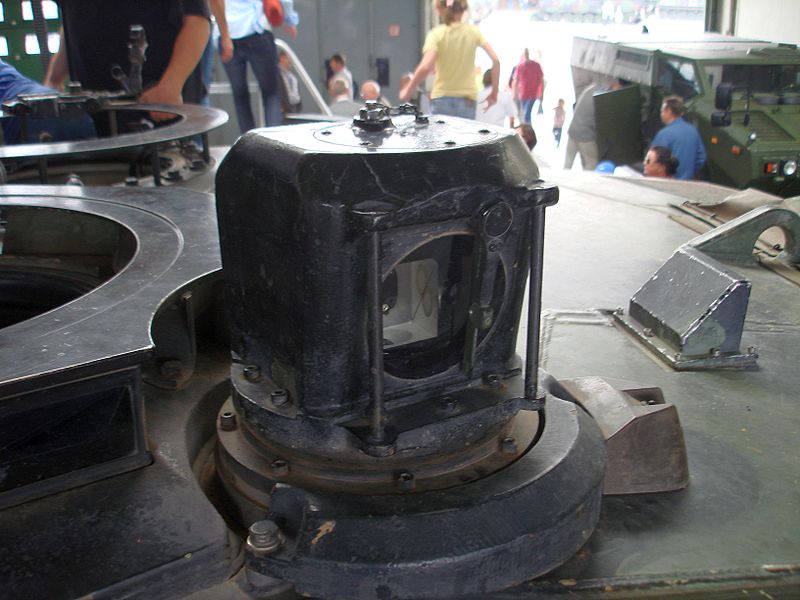
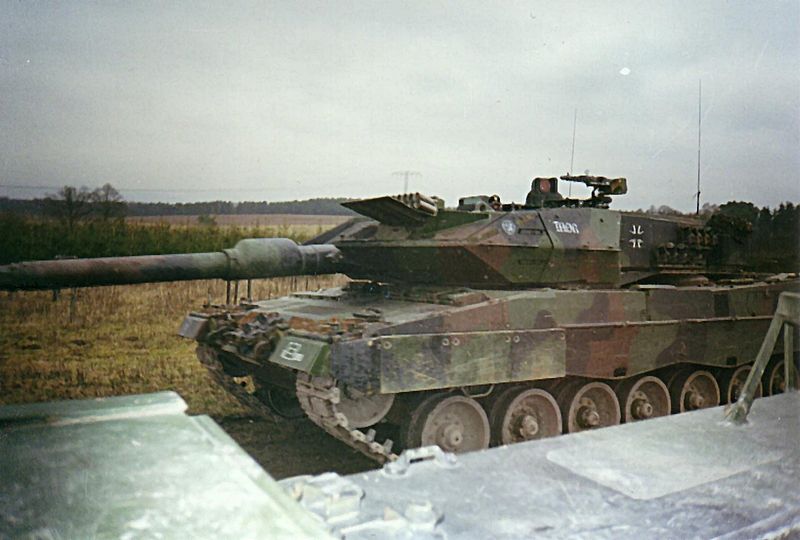
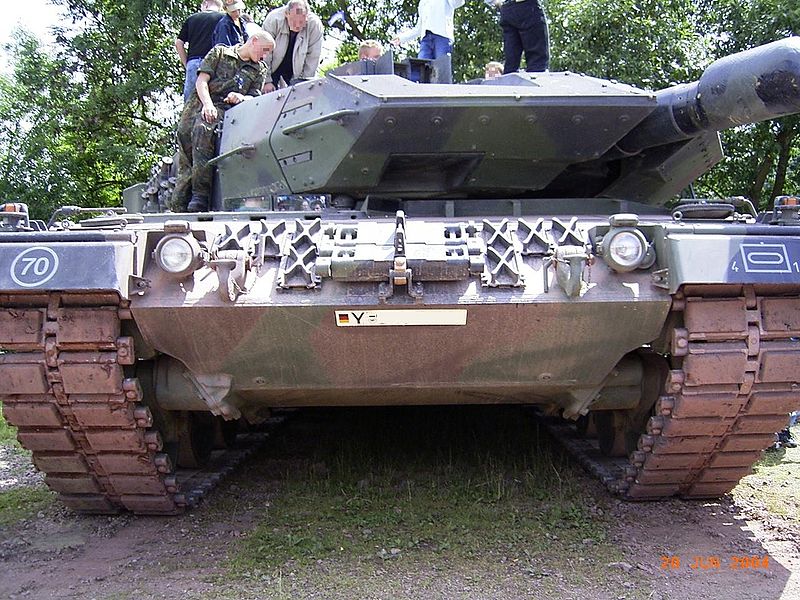

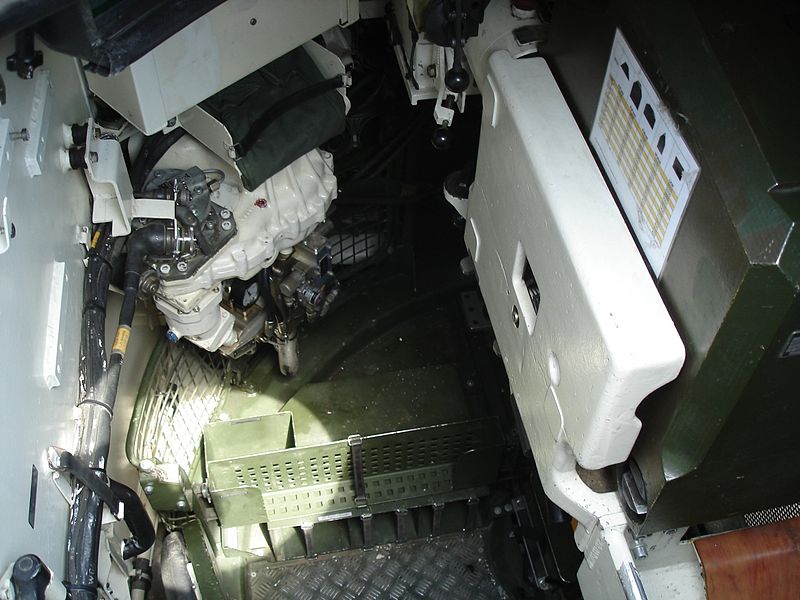
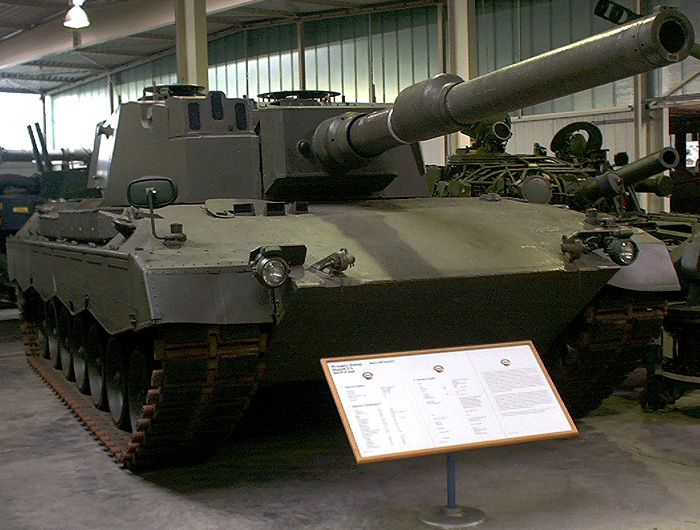
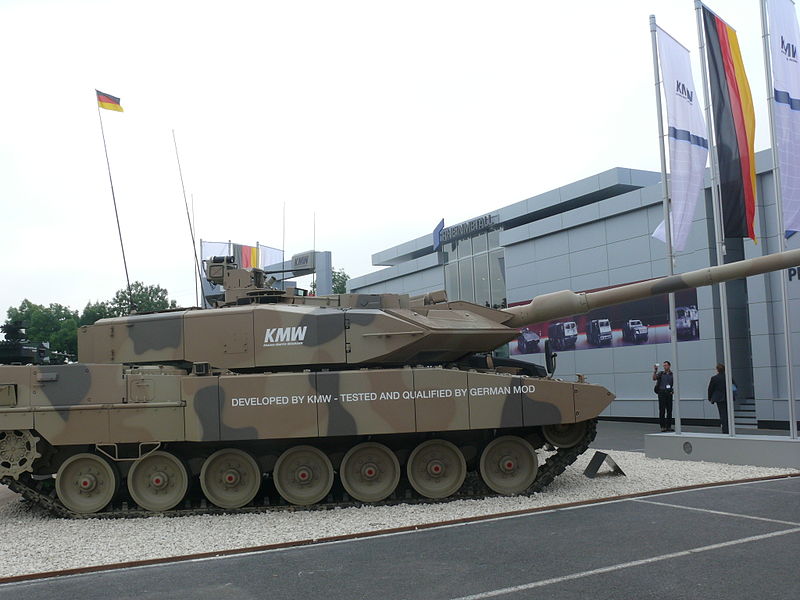
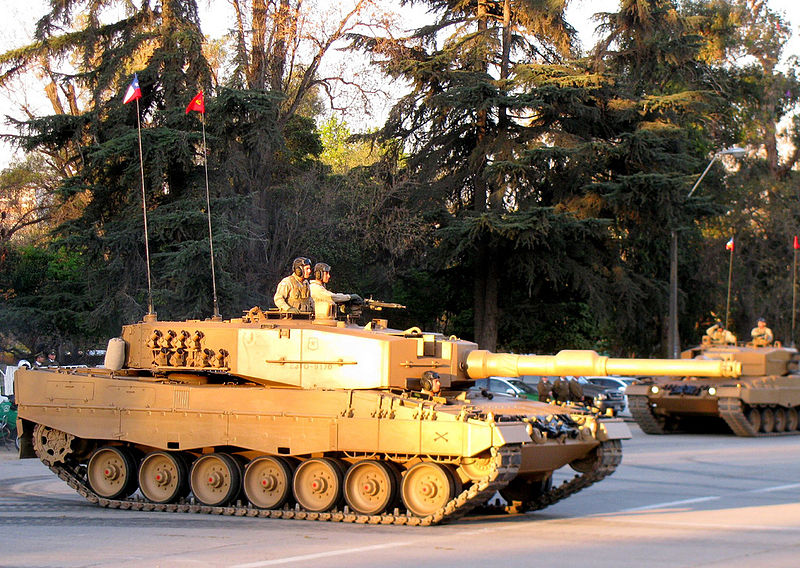
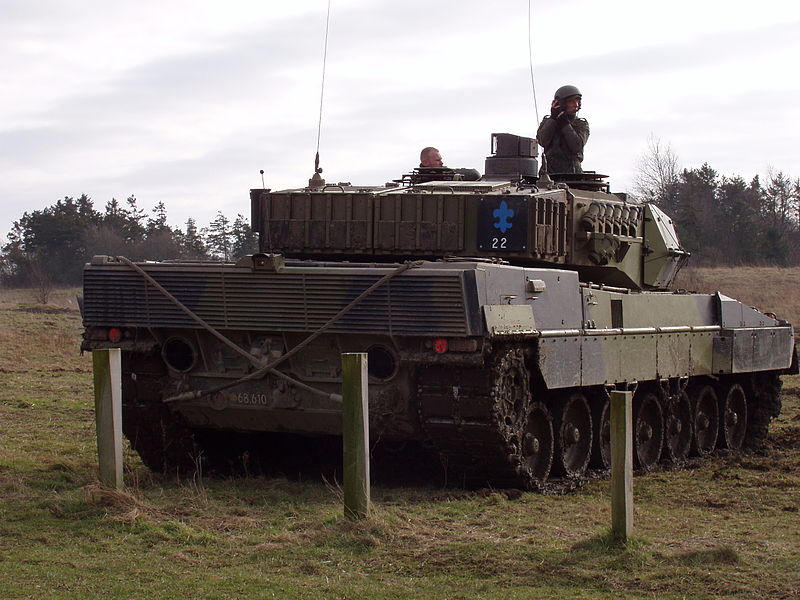
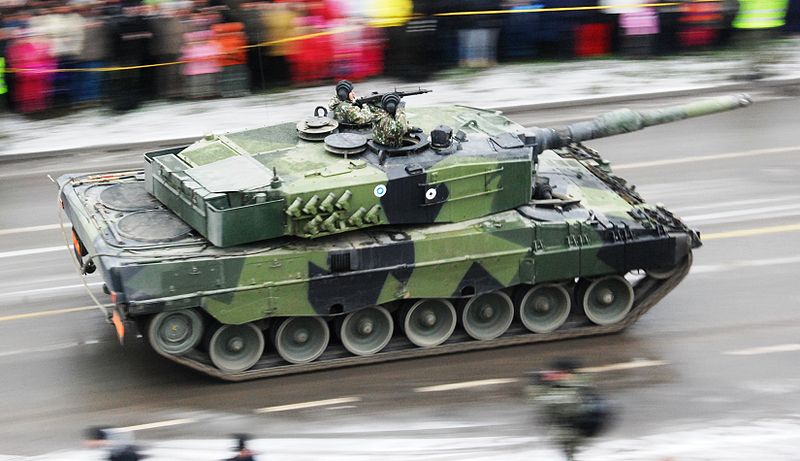

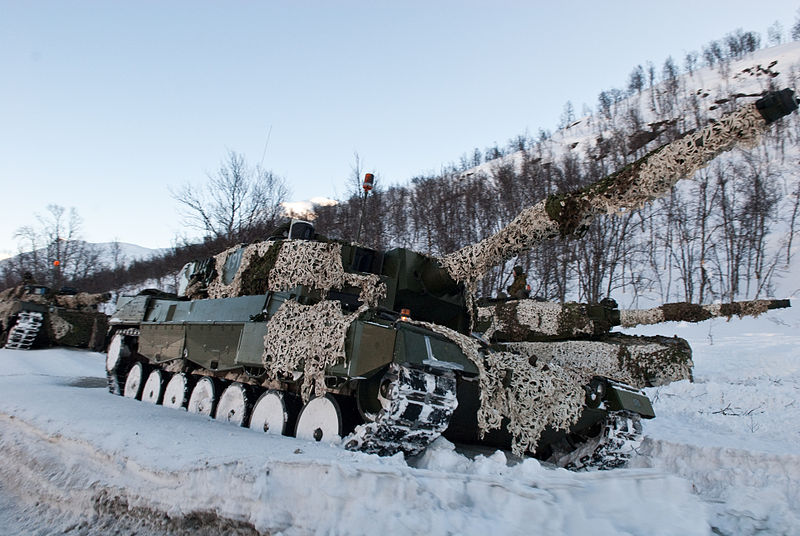
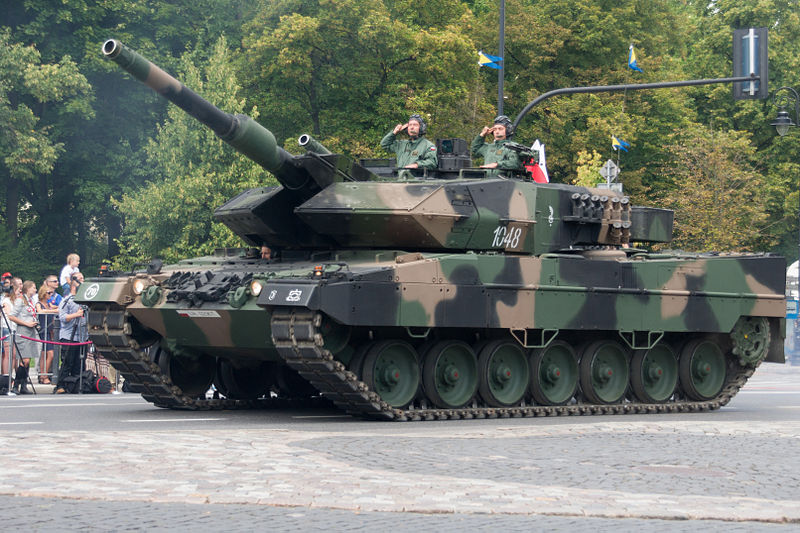

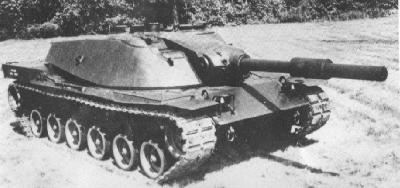
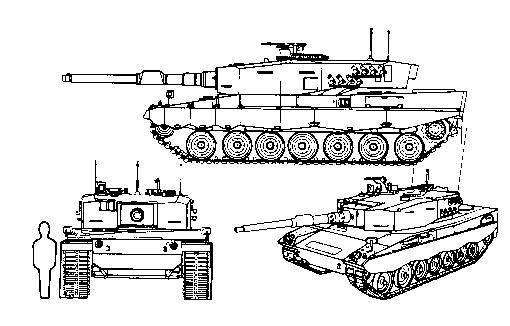
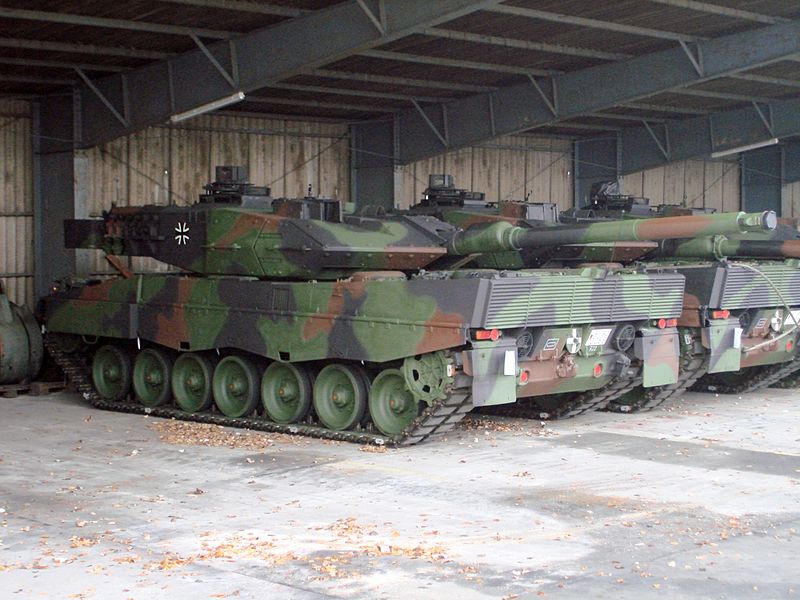
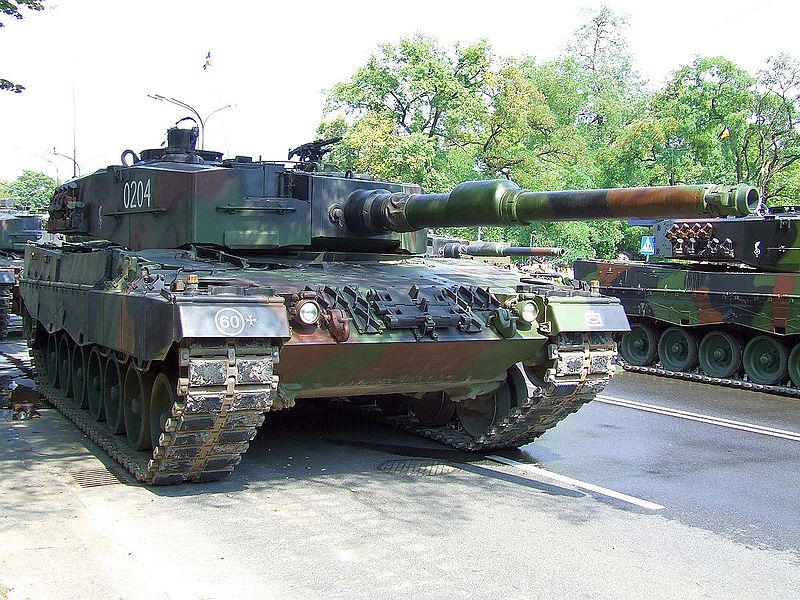
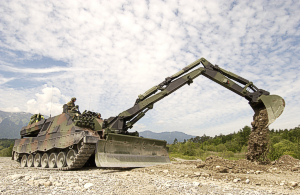
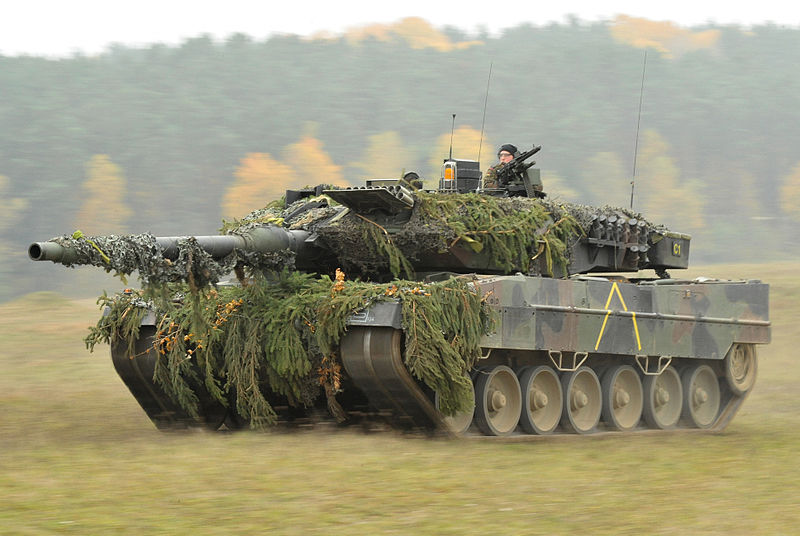
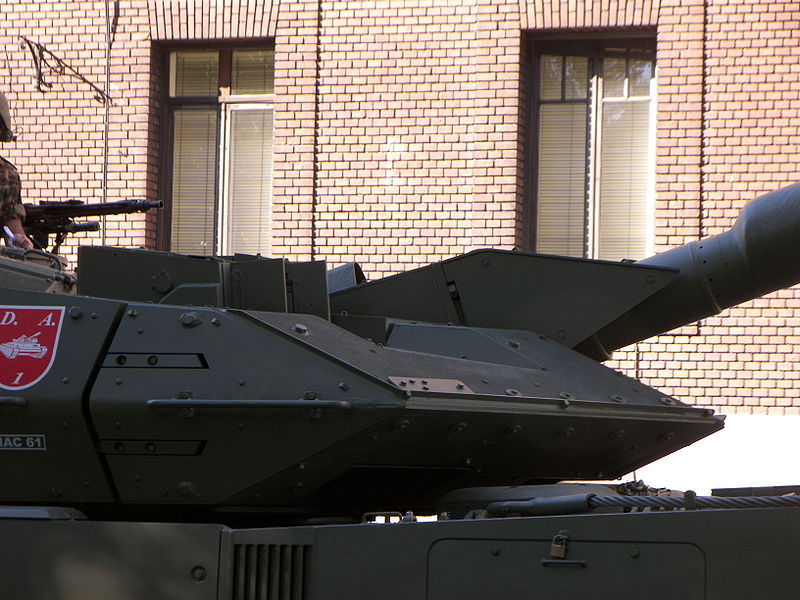
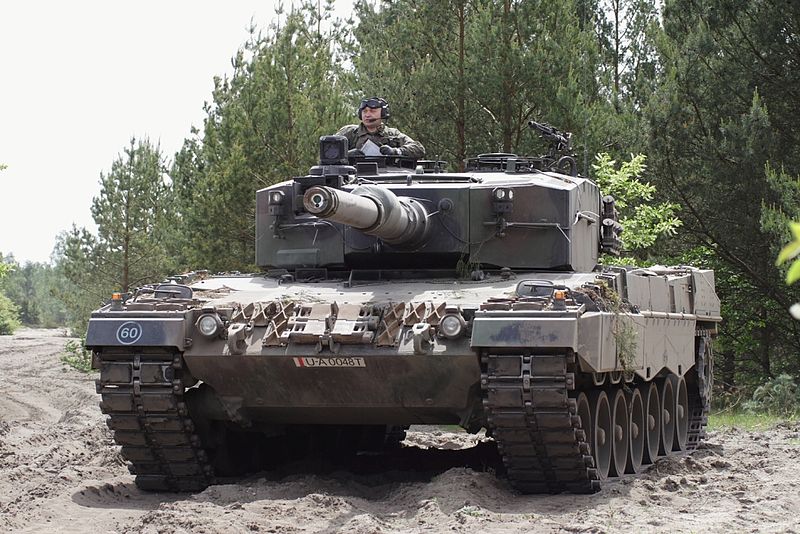
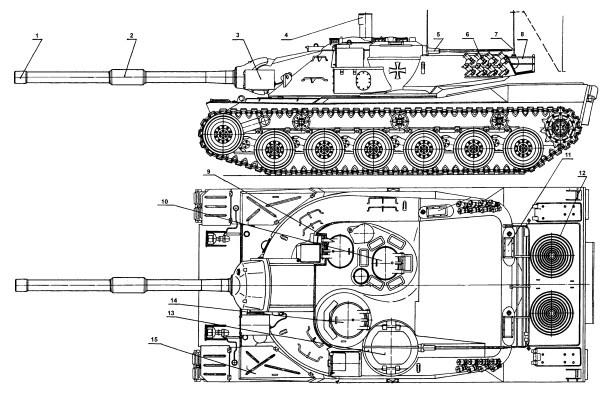
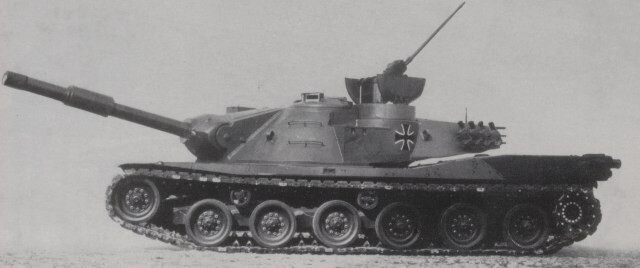
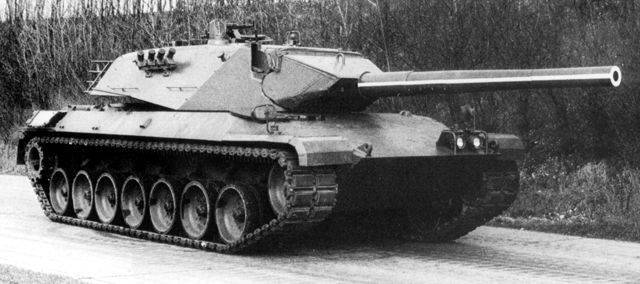

Experimental Entwicklung KPz Keiler or "Guilded Leopard" (1969). This was the first prototype of the future leopard 2
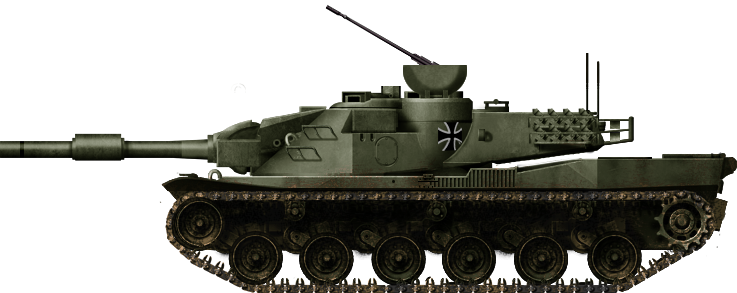
KampfPanzer 70 in 1970. The German version of the joint and ambitious US-German MBT-70 was cancelled due to skyrocketing costs.

Erprobungsserie (pre-serie), 1st batch, first three tanks. These were never fielded to any operational units but kept for tests at KMW.

Leopard-2A0 of the first batch in 1979. Notice the PZB 2000 image intensifier mounted over the mantlet. There was also a wind sensor but not yet any thermal imager.

Camouflaged Leopard 2A1 in the 1980s.

Bundeswehr's Leopard 2A2, first modified batch, 4th kompanie, 33th batallion.

Canadian Leopard 2A2.

Bundeswehr Leopard 2A3 in winter manoeuvers with provisional winter paint.

Leopard 2A3 of the Bundeswehr, Panzerbattalion 123, Panzerbrigade 12, October 1990.

Danish Leopard 2A4DK. Some actively supported British troops during various operations in Afghanistan from 2008 to 2013.

Leopard 2A4 of the Bundeswehr (7th batch), 214th Panzer Batallion, 7th Panzer Division, CMTC Hohenfels, October 1990.

Swiss Panzer 87 (This version includes a Swiss-built 7.5 mm Mg 87 LMG, specific communications equipment, improved NBC. Up to 380 are in service as of today.
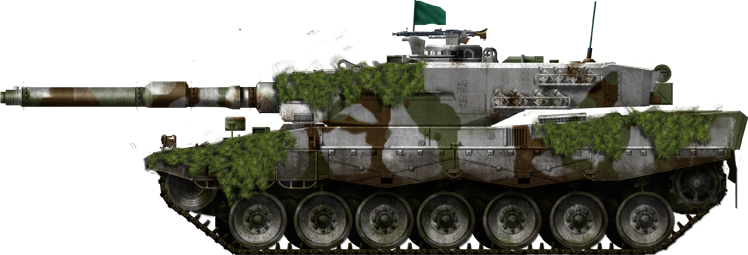
Polish Leopard 2A4, from the 10th Armoured Cavalry Brigade based in Świętoszów.
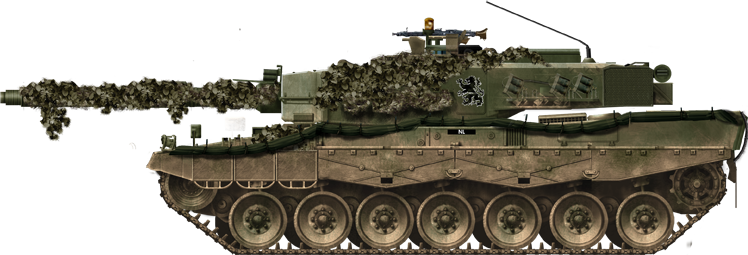
Leopard 2A4 of the 41 NL TankBataljon, 41 lichte brigade Weser-Emsland june 1993.

Leopard 2A4NO, Norwegian Leopard in winter manoeuvrers.

Leopard 2A4 HEL, Greek Army Leopard.

Finnish Leopard 2A4

Leopard 2A5 of the Bundeswehr. Released in 1990, right at the end of the cold war, its tank-to-tank armour capabilities were far superior to any design worldwide at that time. In addition from 1998, 225 former Leopard 2s were upgraded to this new standard. Both the Rheinmetall L44 and FCS are widely improved.

Polish Leopard 2A5

Swedish licence-built Strv-122

Danish Leopard 2A5DK. This version is upgraded to the 2A6 level but retained the same gun.

Leopard 2A6 of the Bundeswehr. Unveiled in 1998 but entering service in 2001, it is equipped with the long barrel Rheinmetall L/55 120 mm smoothbore cannon, and received an improved FCS, updated protection, battle management systems, and a modern hunter-killer capability. The new gun helps to improve both accuracy and range through muzzle velocity, and is a significant advantage over the Abrams. Experts agrees that this version outperforms the latter, but also beats the Challenger and Leclerc in all three summits of the "magic triangle" and therefore could be considered as the world number one MBT.

Spanish Leopard 2E, a locally-built version (2010)

Greek Leopard 2A6HEL as of 2014.
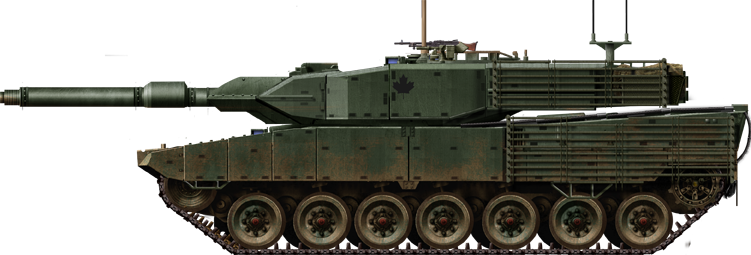
Canadian 2A6M, improved for urban combat, as tested in 2008 to 2013.

Krauss Maffei 2A5PSO (Peace Support Operations) optimized for for urban combat, as desmonstrated at Eurosatory 2008.

Cold War Tanks


































Cold war tanks posters

Cold War Main Battle Tanks

Cold War Soviet Army
Museums, Movies, Books & Games
The Tanks and Armor in pop culture
Tanks and armored vehicles in general are only really grasped when seen first person: The mass, the scale, it's all there. Explore also the way tanks were covered in the movie industry, in books and in video games.Movies:
Best tanks movie on warhistoryonline.com
On imdb.com
On bestsimilar.com/
miltours.com
liveabout.com/
watchmojo.com
Video Games:
pcgamesn.com
historyhit.com
levvvel.com
vg247.com/best-tank-games
mmobomb.com/
alienwarearena.com

